Freely Available British and Irish Public Legal Information
[Home] [Databases] [World Law] [Multidatabase Search] [Help] [Feedback]
England and Wales High Court (King's Bench Division) Decisions
You are here: BAILII >> Databases >> England and Wales High Court (King's Bench Division) Decisions >> Paisley v Linehan (Rev1) [2024] EWHC 1976 (KB) (01 August 2024)
URL: http://www.bailii.org/ew/cases/EWHC/KB/2024/1976.html
Cite as: [2024] EWHC 1976 (KB)
[New search] [Printable PDF version] [Help]
KING'S BENCH DIVISION
MEDIA & COMMUNICATIONS
Strand, London, WC2A 2LL |
||
B e f o r e :
____________________
| DAVID PAISLEY |
Claimant |
|
| - and – |
||
| GRAHAM LINEHAN |
Defendant |
____________________
William McCormick KC and Beth Grossman (instructed by Hemingways Solicitors Limited) for the Defendant
Hearing date: 23 July 2024
____________________
Crown Copyright ©
- The Claimant describes himself as a former actor who campaigns for women's rights and against domestic violence. He also describes himself as a gay man and an LGBT rights activist. The Defendant is a well-known television writer. In his Defence he describes his beliefs as "gender-critical" (that is, he believes that a person's sex is fundamentally immutable and binary and that philosophies that seek to prioritise a person's self-declared gender over their sex can undermine the protection of vulnerable women and girls: see the latest edition of the Equal Treatment Bench Book, Ch 12 at [53]). He says that, since 2018, he has been concerned that transgender rights activism and gender ideology were damaging the rights of biological women and girls.
- In 2020, the Defendant created a Substack account (the Defendant's Substack). Substack is an online newsletter platform to which members of the public can subscribe. Subscribers receive the Defendant's Substack articles by email. The Defendant's Substack can also be viewed at a webpage by subscribers and non-subscribers alike. Subscribers can leave comments beneath the articles on the webpage and these too are visible to any member of the public. The Defendant says that the principal purpose of the Defendant's Substack is to publish articles about issues connected to gender ideology and to women's rights. The Claimant says its principal purpose is to oppose trans rights and members of the LGBT community who support such rights. I do not need to decide, for present purposes, which of these descriptions is more apt. The fact that the Claimant and the Defendant have polarised views on the issues addressed on the Defendant's Substack is readily apparent to any reader of the material that forms the basis of this claim.
- The Claimant has brought a claim for libel and other torts in respect of 7 publications on the Defendant's Substack, consisting of articles posted by the Defendant, readers' comments, or a combination of both. This is my judgment following a trial of certain preliminary issues (as ordered by Master Gidden):
- There is often a fourth issue joined to this list: whether the statement, if a statement of opinion, indicated in general or specific terms the basis of the opinion. Counsel confirmed that its omission on this occasion was deliberate.
- In accordance with settled practice, I read the publications and formed my own provisional views before considering the parties' pleaded cases and submissions.
- The three preliminary issues require discrete answers, but the authorities caution against approaching them "in too linear or compartmentalised a fashion" lest determination of one issue might unfairly stifle consideration of another: see e.g. Bridgen v Hancock [2024] EWHC 1603 (KB) at [17] (Collins Rice J). I have kept that in mind.
- I am concerned with identifying the single, natural and ordinary meaning of the statements complained of, applying the well-established principles re-stated by Nicklin J in Koutsogiannis v Random House Group Ltd [2019] EWHC 48 (QB) at [12] (approved by the Court of Appeal in Millet v Corbyn [2021] EMLR 19):
- Principle (viii) (publication to be read as a whole) derives from Charleston v News Group Newspapers Ltd [1995] 2 AC 65. The House of Lords held that the reasonable reader is deemed to have read the entire "publication" (there, a newspaper article) and that it is contrary to principle to take into account that certain readers will only have read parts of it (such as a headline).
- Principles (iv) & (ix) (avoiding an overly analytical approach; mode of publication) are particularly important in the case of some forms of online publication: see the well-known observations about Twitter, Facebook and online bulletin boards collected in Stocker v Stocker [2020] AC 593.
- As to the other aspect of principle (ix) (context), Nicklin J expanded upon this in Riley v Murray [2020] EMLR 20 at [16], identifying three categories of admissible contextual material:
- When setting out the meaning of a statement, the Court should focus on what it says about the claimant: Sharif v Associated Newspapers Ltd [2021] EWHC 343 (QB) at [33] (Nicklin J). Claimants can (to some extent) choose which aspects of a statement they complain about. When a claimant chooses to focus on just one aspect, "…the judge should not normally make a finding of any meaning which is not either advanced to some extent in the statement of case or submissions of one or other party, or within the same class or range as a meaning so advanced": Yeo v Times Newspapers Ltd [2015] 1 WLR 971 at [82] (Warby J) and Swan v Associated Newspapers Ltd [2020] EWHC 1312 (QB) at [24]-[25] (Warby J).
- From these principles, it can be seen that clarity is needed on three things before the Court can safely embark on a determination of meaning. First, the statement(s) complained of must be clearly identified. Second, the "publication" (that is, the set of words and images within which the statement complained of sits) must be clearly identified. That is essential because it is that "publication" to which the rule in Charleston applies. Sometimes the publication will be coterminous with the statement complained of. Sometimes it will be obvious what the publication is (a free-standing newspaper article for example). In other cases (e.g. a front page article followed by a longer article on an inside page) there will be scope for argument about what falls to be treated as part of the publication and the Court will have to determine the matter adopting the approach taken in Dee v Telegraph Media Group Ltd [2010] EMLR 20 (Sharp J).
- Clarity on these matters is particularly important in the case of online publication. Online articles are prone to be altered from time to time. Below-the-line comments are added and sometimes deleted as time goes by. Often, it will not be proportionate to sue on some later-amended version of an article, because most readers will have only seen the original version close to the time of first publication. Similarly, it will often be disproportionate to sue on below-the-line comments which may have attracted very little readership. But there are exceptions. If there is some good reason for suing on amended versions of an article, it is incumbent on the Claimant to identify what the changes were and when they were made. Likewise, if there is a good reason for suing on readers' comments, it is important to specify the point(s) in time at which the Court is being asked to assess the situation, and the state of the comment thread at that time.
- These requirements all flow from basic principles, but they are reinforced in some respects by PD 53B paragraphs 4.1-4.2. I am labouring the point here because, in this case, the requirements were not entirely adhered to and it has caused complications.
- Nicklin J summarised the approach to distinguishing factual allegations from opinion in Koutsogiannis at [16]:
- In Blake v Fox [2023] EMLR 12 at [32]-[34] & [55] (upheld on appeal) Nicklin J accepted a submission that certain words (e.g. "racist") are more inherently likely to be classified as opinion than others (e.g. allegations of criminal conduct). He also acknowledged however that, "even the use of heavily value-laden judgment terms in a publication may not prevent a finding that the overall effect of a publication is to convey an allegation of fact", and I was shown a number of cases in which Judges have held that words which might be thought to be evaluative in character (including "homophobia" and "misogyny") have been held to convey statements of fact in the context in which they were used: see e.g. Alam v Guardian News and Media Ltd [2023] EWHC 2847 (KB) at [63]-[69] (Griffiths J). Ultimately, it is all dependent on the context.
- One relevant consideration will be whether the statement relates to material the claimant himself has publicised. Again, without wishing to over-generalise, a statement which, on its face, is a response to such material may well incline the reader towards interpreting it as opinion, not fact: Butt v Secretary of State for the Home Department [2019] EMLR 23 at [29], referring to Keays v Guardian Newspapers Ltd [2003] EWHC 1565 [45]-[48] and Kemsley v Foot [1952] AC 345.
- A statement is defamatory at common law if (1) it satisfies the "consensus requirement" (i.e. it would tend to lower the claimant in the estimation of right-thinking people generally) and (2) it would tend to have a substantially adverse effect on the way that people would treat the claimant: see e.g. Millett v Corbyn at [9] (Warby LJ).
- Some of the submissions by counsel for the Defendant, William McCormick KC, were centred around the notion of "vulgar abuse". In Smith v ADVFN Plc [2008] EWHC 1797 (QB) at [17] Eady J described this as:
- In Blake v Fox at [27] Warby LJ cited what is said in Gatley on Libel and Slander (13th ed) at para 3-037:
- It seems to me there is room for debate about where "vulgar abuse" fits in the modern law. It may depend on the particular words used. A single-word insult might best be analysed as not conveying any meaning about the claimant at all. All it does is tell the reader something about the defendant (that he is angry, upset etc). By contrast, a declarative sentence containing abusive terms might well be understood to be saying something about the claimant, but not anything that the reasonable reader would take seriously, such that it is not defamatory at common law. Conceivably, some abusive statements might pass the common law test but their abusive nature may be a relevant consideration when the court considers "serious harm" under Defamation Act 2013, s.1. I do not think the precise analysis matters greatly, so long as the points made by Eady J and Warby LJ are not lost sight of.
- I note that in Blake v Fox at [53], Nicklin J said, "In my judgment, an allegation that a person is a paedophile does not qualify in the sense of being mere abuse as indicated in [the passage from Gatley set out above]". However, I do not read that as a categorical statement that holds true in all circumstances. Nicklin J was considering the particular Tweets in question, having given himself the orthodox self-direction that the issues he was considering are heavily dependent on context.
- As mentioned above, subscribers were able to post comments under the articles on the Defendant's Substack. There was a certain amount of pleading and evidence about the mechanics involved. The Defendant pleads that when a reader reaches the end of an article "the first and second comments are automatically visible immediately below it with an indication of the total number of comments that have been made". It is unclear what is meant by "the first and second comments" but, from comparing printouts in the hearing bundle of the same article accessed at different times, I can see that it will not always be the same two comments. Perhaps it is the two most recent comments? Or the two that have received the most "likes"? Anyway, what is clear is that the comments appearing immediately beneath the article and thus visible without any effort to a reader who reaches the end of the article will change over time. The Defendant then pleads that the reader must "click through" to see any of the other comments, and that "When "clicking through" a reader may select the order as "top first", "new first" or "chronological". So, again, different readers will see different things when they access the complete comments, not only because comments will be being added or deleted in real time, but because the immediate context of any particular comment may be different depending on which display option the reader chooses.
- As well as posting comments on the article, it seems that readers can click on an existing comment and reply to or comment on that. There is an unresolved question about how accessible such sub-threads are to people looking at the main comment thread. I return to this under Publication 1 below.
- My first impression, when reading each of the articles, was that the Defendant was criticising the Claimant for the way he deals with those who express views in the trans rights debate that are opposed to the Claimant's own views, particularly women who adopt a gender-critical stance. This is said to include reporting them to the police for things they have published online. The Defendant frequently says the Claimant is engaged in bullying and harassment. It struck me that these allegations were preponderantly factual in nature because they were so categorical and did not seem to signal to the reader that they were just the Defendant's subjective reaction to things the Claimant had said and done.
- Some of the readers' comments struck me as going further and making allegations of paedophilia at some level. Some comments struck me as just abusive, saying more about the commentator than the Claimant.
- "Publication 1" consists of a set of comments posted on 13 December 2020 in response to an article posted by the Defendant on the same date. No complaint is made about the article itself, but it is agreed that it is relevant context. The article is headed "News from Clown World", and then "Let's see what's happening in the world of clowns!". It is a sort of derisive round up of the recent activities of trans rights activists. The second item is headed "David Paisley, leave LGB people alone". It has a picture of the Claimant, then a screenshot of tweets by someone noting that the Claimant has referred to a LGB organisation as "widely viewed as a hate group" but commenting that he has only been able to make that allegation because the Claimant himself propagated the view that they are a hate group. The Defendant then writes "This is very telling. Using his own actions as evidence" and then includes a screenshot of another tweet making the same point. The article then moves on to other "clowns".
- Immediately before (chronologically) the comments that the Claimant complains of, a reader writes:
- Then the comments continue:
- There is a dispute, which I cannot resolve, as to whether a reader needed to perform additional clicks to reach the indented comments. However, the Defence pleads "The Defendant will rely upon the entirety of the article and all the comments below it as context…" and the Reply says, "it is admitted that the comments are to be interpreted in the context of the entire comment thread" so, whatever the mechanics, both parties agree that the reasonable reader would read all the comments together. One of the comments is by the Defendant himself but the Claimant does not contend that his comment is defamatory. The alleged sting arises from what "Broni" and "Lida H" say.
- The Claimant's case is that the comments mean that "The Claimant is a paedophile" or alternatively "The Claimant is a paedophile sympathiser" or alternatively again "There are reasonable grounds to suspect that the Claimant is a paedophile [alternatively a paedophile sympathiser]". Mr Henderson, counsel for the Claimant, submits that this is a statement of fact. He says that, although this is a chatty exchange between two readers, it would be taken seriously and the statement that someone is a possible paedophile is not something liable to be understood as the stuff of idle gossip.
- The Defendant does not set out a rival meaning. He contends that this is just idle gossip which no reasonable reader would take seriously (vulgar abuse, in other words). He points out that what is said about the Claimant in the article itself has nothing to do with paedophilia; that the comments are the sort of unserious chat that Eady J considered in Smith v ADVFN; that Broni is plainly an unreliable fantasist because she says that paedophiles "only get outed when they die" when Lida H has just mentioned Rolf Harris who, everyone knows, was convicted; and that Lida H's flippant responses show that even she is not taking seriously what Broni says.
- In my judgement, the statement complained of in Publication 1 means that "The Claimant has an unhealthy interest in small children and there is a real possibility that he may be a paedophile". That meaning is conveyed by way of an expression of opinion and it is defamatory at common law.
- Although I accept that the word "paedophile" might be used as a mere insult that conveys no real meaning, that is not how it is being used here. Broni does not just use the word, she elaborates on why she is applying it (tentatively) to the Claimant. She explains she has found material of his online that suggests an unhealthy interest in children and, when Lida H makes a flippant reply, Broni returns and offers more explanation ("He has posted some pretty dodge stuff…"). The fact that the article itself does not mention the Claimant in the context of paedophilia does not mean, in my judgement, that when his name is used in that context in the comments, the reader would dismiss the exchange as idle banter. It is not unusual for comment threads to veer off the topic of the article under which they appear. Whether what is said on a new topic will be taken seriously will depend on the content of the exchanges.
- The Claimant's meanings are too high however. It is clear to the reader that Broni has seen some of the Claimant's posts online, assessed those as showing, in her opinion, an unhealthy interest in children and has then reached the view that this in turn gives rise to a possibility that the Claimant might actually be a paedophile. Because Broni is making a comment, it is not helpful to try to categorise the meaning by reference to Chase levels (Chase v News Group Newspapers Ltd [2003] EMLR 11), but it clearly falls short of alleging that the Claimant is, or is reasonably to be suspected of being, a paedophile.
- Reasonable readers would recognise Broni's words as comment. It is obviously her subjective assessment of material the Claimant has chosen to put before the public online. She does not claim or imply that she knows of any actual conduct by the Claimant. In my judgement, both the "unhealthy interest" and the "possible paedophile" elements would strike the reader as comment when the exchange is read as a whole.
- The meaning is defamatory at common law. The suggestion of paedophilia is made tentatively but Broni is much firmer in her assessment that the Claimant's materials show an unhealthy interest in children. And in any event, paedophilia carries such stigma in society that even the suggestion that there is a real possibility someone is a paedophile has a tendency to have a substantially adverse effect on their reputation.
- "Publication 2" is an article posted on the Defendant's Substack on 21 October 2021. Rather like the article in Publication 1, it is a sort of round-up of the recent activities of the Defendant's ideological opponents. It starts with a head line and sub-heading:
- There is then a screenshot of another Twitter exchange that refers to the Claimant, and which would be read as part of the context, but neither party places reliance upon it and I do not need to set it out. I agree it makes no difference.
- The Claimant's meaning is that "The Claimant has made a false police complaint motivated by his hatred of women/lesbians". He says this is a statement of fact which is defamatory at common law. The Claimant's submissions were mostly devoted to attacking the Defendant's case rather than developing his own.
- The Defendant's meaning:
- The underlined passages, the Defendant says, are comment, and he accepts that the statement, in his meaning, is defamatory at common law. The Defendant says his meaning better reflects the impression the totality of the words would have made on the reasonable reader. He says that the vast majority of the criticisms of the Claimant would be instantly recognised as the Defendant's opinion on the Claimant's conduct in making complaints to police forces about women or lesbians. He also submits that the actual epithet applied to the Defendant's latest complaint is "apparently vexatious" and it is wrong for the Claimant to gloss this as "false".
- My initial impression was that Publication 2 was saying something about the Claimant's conduct in general, and presenting his complaint to the PSNI as just the latest example. I was therefore somewhat surprised to see that the Claimant's meaning is focussed purely on the latest complaint. Mindful of what Warby J (as he then was) said in Yeo and Swan, I consider that I am entitled to, and should, find a meaning that, to some extent at least, encompasses what is said about the Claimant more generally, as the Defendant invites me to do. To restrict the meaning to a single episode, when reasonable readers would not understand it in this way, might unfairly restrict lines of defence that may be open to the Defendant.
- Accordingly, in my judgement, the statements complained of in Publication 2 mean that: "The Claimant has targeted a lesbian woman by making a complaint to the police that appears to be vexatious, and this is the latest step in his campaign of misogynistic and homophobic harassment, in the course of which he has lied." The underlined words are opinion. The meaning is defamatory at common law.
- In my judgement, the reasonable reader would not assume that, on this latest occasion, the Claimant has been lying. "Lying" is used in relation to how the Claimant has behaved in the past. The present complaint is described by Rob Marchant as "apparently vexatious" and it is this suggestion of vexatiousness that the Defendant picks up when addressing the specific incident in question ("[the Claimant] has decided that targeting a lesbian mum of two is a good use of his time on this earth"). This stresses the triviality and oppressiveness of the complaint, not its truth or falsity. I do not agree however that, in respect of his previous conduct, the article alleges only that the Claimant had made complaints that he "knew or should have known to be false". That is a gloss on the ordinary meaning of "lying" which receives no support from the words used in the article.
- Reasonable readers would recognise the description of the Claimant's latest complaint as comment: Rob Marchant is obviously reacting subjectively in light of whatever he knows about Femme Love's Tweets when he describes the complaint as "apparently vexatious". The Defendant's language, insofar as it pertains to this particular incident, echoes what Rob Marchant says and goes no further.
- By contrast, I do not accept the Defendant's submission that what is said about the Claimant's conduct in general would be understood as comment by the reasonable reader. Terms like "homophobic" and "misogynistic" have a strong evaluative element and there is scope for disagreement about the sort of conduct they can be applied to, but the authorities amply demonstrate that this does not prevent them from amounting to allegations of fact in the context of the particular publication complained of. No clue is given as to why the Claimant's prior conduct should be assessed as homophobic, misogynistic or dishonest. The reader is simply told, as a matter of historical fact, that he has engaged in a homophobic campaign of harassment, and that he is a "lying, misogynistic blowhard".
- "Publication 3" does not identify the Claimant by name but there is a reference innuendo pleaded and I am asked to decide the preliminary issues on the assumption that at least some readers will have understood it to refer to the Claimant.
- Publication 3 is an article published on the Defendant's Substack on 22 October 2021. It consists almost entirely of the script of a speech delivered by Ceri Black. The Defendant's own contributions are limited to the following. First, a headline:
- The script of Ms Black's speech is too long to set out in the body of this judgment but I attach it at Appendix 1. In summary she explains that the police have requested her to attend an interview under caution as a result of a complaint about her Tweets. She describes the nature of what she posts on Twitter (essentially she takes a gender-critical line). She says that this has sometimes resulted in online threats of rape and murder and homophobic abuse which she has reported to the PSNI but in respect of which the PSNI took no action. She contrasts this with the situation she is facing:
- The Claimant contends that the words he complains of in Publication 3 bear the following meaning, which is an allegation of fact and defamatory at common law:
- The Claimant argues that the use of the word "harassment" together with Ms Black's reference to employing "all legal means" to have his conduct stopped, and to having consulted a solicitor, combine to suggest that what is being alleged here is the criminal offence of harassment. He also says that, on a fair reading of Ms Black's speech, the only basis that is suggested as to why the Claimant is harassing her is the fact that she has published Tweets aimed at preventing children being groomed, so that this should feature in the meaning. Lastly, the Claimant says that "malicious" is the proper way to characterise the description of the Claimant's complaint given in the article, rather than "vexatious" or "spurious". He relies on the use of "malicious" in the screenshot at the end of the article, albeit accepting that this is not actually pleaded as part of the statement complained of in the Amended Particulars of Claim. On the fact/comment issue, the Claimant argues that the 6th and 7th questions Ms Black poses to PSNI assert, as fact, that the Claimant has engaged in harassment in the past, including by making vexatious police complaints.
- The Defendant pleads the following meaning:
- The Defendant acknowledges a degree of common ground with the Claimant as to meaning but disputes that the reasonable reader would understand the article to be alleging criminal conduct. He says that "spurious" or "vexatious" is the better way to reflect the description of the Claimant's complaints given in the article. He disputes the inclusion of an allegation that the Claimant has incited others to target women; and he disputes the suggestion that the Claimant was motivated to complain by the fact that Ms Black was trying to prevent children being groomed. The Defendant says that the underlined passages in his meaning relate to the Claimant's personality ("a misogynist bully") and his motivation ("to silence those with whom he disagrees on issues of the risks to women and children from gender self-identification") and that readers would have appreciated that the Defendant could not be stating anything factual about the Claimant's motivation but would have been making an inference or deduction and hence expressing an opinion.
- In my judgement, the statements complained of in Publication 3 meant: " the Claimant has engaged in a campaign of bullying and harassment aimed at silencing women who disagree with him, including by making spurious and vexatious complaints to the police". That is entirely a statement of fact and it is defamatory at common law.
- My formulation is notably shorter that those of the parties, but I find both their approaches to be over-analytical. I do not think that an ordinary reasonable reader, reading this article once, would pick up all of the subtleties that the parties rely upon. I have tried to capture the impression that the article would make. It is important, I think, that reasonable readers would recognise they were reading the text of a speech, and would recognise that various rhetorical devices are used within it to get the speaker's essential message across to the audience.
- I do not consider that the reasonable reader would consider the article to be making an allegation of criminal conduct. Of course, in law, harassment is both a tort and a crime and both have the same ingredients, but the reasonable reader is not a lawyer. I consider that "spurious and vexatious" captures the criticism of the Claimant's complaints better than "malicious". I recognise that the word "malicious" is used in the final screenshot (added by the Defendant), but it comes right at the end of the article and is not presented in a way that suggests it is adding to anything that has already been said. I think it is unlikely to displace in the reader's mind the impression that has already been formed. I have excluded from my meaning anything about what the Claimant's followers do. I think it is strained to say that he is accused of "inciting" others to act. The fact that his followers act in the same way as him (which is alleged) reflects on them rather than him. I have also not included any specific meaning derived from "terrorising women". I consider that a reasonable reader would regard this as a rhetorical repetition of the basic allegation of harassment. I do not think a reasonable reader would understand the article to be alleging that, specifically, the Claimant was motivated by the fact that Ms Black was trying to prevent children being groomed. The article never sets out the specific Tweets that the Claimant has complained about, and Ms Black gives an account of her Twitter activity that suggests it is wide-ranging. It is true that she says, at one point, "Come and arrest a lesbian woman…for the crime of tweeting about how to protect children from grooming and sexual predation" but I consider that, given the general rhetorical nature of the script, a reader is unlikely to understand this as identifying the subject matter of the specific Tweets that the Claimant has complained about or, hence, to understand the article to be alleging that the Claimant was motivated by a desire to stop Ms Black from seeking to prevent grooming or sexual predation.
- Lastly, I do not think that the "non-defamatory" parts of the Defendant's meaning are necessary and I agree with the Claimant that, applying Sharif, the criticisms of the PSNI in the Defendant's meaning are insufficiently connected to the Claimant and should be excluded.
- As to fact/opinion, the tone of the article is strongly factual. I do not think that the reasonable reader would interpret it as merely Ms Black's subjective assessment. The focus is on how the Claimant has behaved in the past, which is asserted as a matter of historical fact and then deployed as a reason why the PSNI should not indulge the Claimant on this particular occasion. No detail is given as to why Ms Black considers the Claimant's past conduct to amount to harassment, or why she thinks his previous complaints were vexatious and spurious, and so the reader is given the impression that they are being presented as the incontrovertible truth.
- This is problematic. What the Claimant refers to as "publication 4" in fact comprises an article first published on the Defendant's Substack on 24 October 2021 (but then altered at an unspecified later date) plus up to 54 comments that were posted (and in one case, deleted) between 24 and 28 October 2021. The Claimant complains about both versions of the article and 14 of the comments. At paragraph 6.10 of the Amended Particulars of Claim, the Claimant pleads:
- The Claimant pleads that, whatever the statement complained of comprises, it bears the same meaning:
- This pleading is confusing and, in my view, misconceived. The Claimant is effectively asking the Court to treat the article and comments as a single publication, and then to consider what meaning would be conveyed to different groups of readers who should be taken to have read (variously) just the article, just the comments (or an unspecified number of them), or the article and all the comments. That is inconsistent with the rule in Charleston. Moreover, it is unreal to treat the parts of the article complained of and a series of comments posted over the ensuing 4 days as a single "statement".
- Mr McCormick KC submitted that the article should be regarded as a stand-alone "publication" for the purposes of Charleston. I agree with that: first, subscribers who had the article emailed to them will only have seen the article; second, even for online readers, the end of the article is the natural finishing point: reasonable readers would stop there. Only a subset of readers would be interested enough to look at comments; third, I have already mentioned the instability of the comment thread – even the two that appear at the foot of the page where the article ends appear to change.
- So, I can and will give rulings in respect of the article read in isolation.
- As to the comments, it seems to me that each of those must be treated as a statement in in its own right (and, coterminously, a "publication" for Charleston purposes) except where there is a group of closely related comments which, it can be said with certainty, would have been seen together by all readers (in which case the analysis would be that each group of comments was a single publication or that, in any event, each comment within the group was admissible context for the interpretation of any particular comment within the group).
- At the hearing, I contemplated and canvassed with counsel the possibility of giving a ruling on meaning (etc) for each comment or group of comments relied upon by the Claimant. However, on reflection, I have decided that I cannot safely do so without risking injustice to one or both parties. I do not have the benefit (as I did in respect of Publication 1) of a clear agreed position as to what a reasonable reader would have seen. The Defence pleads that "The Defendant will rely upon the entirety of the article and (to the extent that the Claimant relies upon comments, upon all comments visible at the material time)". No one was prepared to identify to me the point(s) in time at which I was being asked to assess the state of the comment thread and, hence, no one was able to tell me what "the material time" meant.
- I can illustrate the problem as follows. At some point on 24 October 2021, a reader going by the name of William A. Ferguson posted the following comment:
- Clearly the meaning of these comments will have changed, depending on what was visible to a reader at any particular time and as a result of the particular display options they had chosen. The initial comment might, perhaps, amount to mere vulgar abuse; the Defendant then deems it "unhelpful", undermining what credence it might otherwise have had; William A. Ferguson then retorts with reasons for his initial comment (which might perhaps take it out of the realm of vulgar abuse), but then the Defendant's final comment appears to refute Mr Ferguson's allegation altogether. And at some point, during or after these exchanges, the initial comment was deleted, which might be thought to render the whole remaining string meaningless to readers who saw it after the deletion.
- I have come to the conclusion that I cannot make a fair determination of meaning (etc) in relation to any of these comments without knowing whether some or all of these comments would have been seen together by all reasonable readers (regardless of which settings they used for viewing the comment thread) and without knowing the point(s) in time at which I am being asked to assess these issues.
- The problem is replicated in respect of the other comments relied upon by the Claimant. I have no sure guide as to whether they fall to be assessed alone or as part of a group of interrelated comments.
- The fact that the Claimant contends that the same meaning is conveyed, whatever material is looked at, is no answer. The Court may not agree. I note that the Defence pleads a compendious meaning for the whole of "publication 4" in response to the Claimant's own compendious meaning, but the Defence was critical of the Claimant's approach, which was then described as "problematic" by Mr McCormick KC in his skeleton and oral submissions. So, I do not think that the Defendant can be said to have acquiesced in the Claimant's approach. Mr McCormick KC was not opposed to the idea that I should formulate meanings for specific comments or groups of comments, and did his best to propose meanings on his feet. However, he made the persuasive point that, if there is a problem with identifying the statements complained of, and the meanings to be attached to them it is, in the first instance, the Claimant's problem, not the Defendant's.
- So, in light of all this, I decline to determine any of the preliminary issues in respect of the comments posted under the article. If the Claimant seeks to have these issues determined, he will first have to set out his case as to the meaning of each individual comment or, as the case may be, each group of comments which fall to be considered together. If he relies on groups of comments, he will need to articulate a case that all reasonable readers will have read those comments together. He will need to explain to the Court the point(s) in time that he is asking for the position to be assessed, so that the Court can form a reliable view as to (a) whether, at that time, all the comments that are alleged to form part of a group would have been available to the reasonable reader and (b) what might fall to be considered as extrinsic context at that time. The Claimant may wish to reflect on whether pursuing a case based on the comments is proportionate, given the extent of the other material on which the claim is founded, but that is a matter for him.
- Turning then to the article, even this is not straightforward because the Claimant relies on two versions. The article begins with this headline and subheading:
- The Claimant places reliance on the photograph. He says the photo portrays him showing satisfaction, and that this contributes to the meaning. I disagree. The inclusion of the photograph certainly alerts the reader to the fact that the Claimant will be mentioned in the article. That might have some significance on the question of serious harm but it does not, in my view, change the meaning that the reasonable reader would take from the article having read it all the way through. The picture does show the Claimant smiling and giving a thumbs up, but it is impossible to tell what it is he is supposed to have been approving. Accordingly, I can give a single set of rulings in respect of both versions of the article.
- The full article is set out in Appendix 2. Beneath the headline and sub-heading, the Defendant writes (italics in original):
- The Claimant's primary case is that this article means, "The Claimant is a paedophile. The Claimant manipulates the police by making malicious criminal complaints. He is committing a criminal offence in doing so, and he ought to be charged. He does so in order to bully and silence women, including a victim of child sex abuse because she has exposed him for assisting paedophiles.". He also pleads some alternative meanings. He says this is a statement of fact and defamatory at common law.
- The Claimant says this is a "rogues gallery" case: he argues that the reader learns that he once featured in this thread identifying a long list of "paedophiles and their enablers" and would think that he was another such person. Readers will understand that his name was only deleted because he bullied Ms Black into deleting it, not because he did not belong on the list. He places great emphasis on the fact that the word "normalise" is used in the introduction to the thread, the thread itself, and then the passage immediately after the thread dealing specifically with the Claimant ("Paisley has just spent a great deal of energy trying to normalise children seeing the genitals of a man…").
- The Defendant's meaning is:
- The Defendant argues that the article (insofar as it mentions the Claimant) is about "the risks posed to children as a consequence of what [the Claimant] writes, not that he wishes those risks to materialise". He says that Ceri Black's thread is wide-ranging and is not just about identifying advocates or apologists for paedophilia but also about the need to maintain firm boundaries around adult contact with children and to ensure safeguarding. He says that the underlined passages in his meaning are opinion because they will be recognised as commenting on the Claimant's personality and the quality of his conduct.
- In my judgement, the article means: "The Claimant bullied Ceri Black into removing an allegation from a Twitter thread that he was spreading an anti-safeguarding line even though that was an apt description of what he does because he seeks to normalise adult nudity in the presence of children. This bullying behaviour is evidence that the Claimant is a dangerous narcissist and misogynist and a vexatious troll who deserves to be charged with wasting police time.". The underlined words are opinion. The meaning is defamatory at common law.
- I do not think the reasonable reader would conclude that the Claimant was a paedophile or a paedophile enabler or sympathiser. The Claimant's case relies on mental gymnastics that are not a characteristic of the hypothetical reasonable reader and a propensity to derive the worst possible meaning (again, not something the reasonable reader does). The Claimant posits that, having been told that the Claimant had featured in the original thread, the reader would assume that he must have been listed alongside the despicable people and organisations who advocate child abuse and the grooming of children. But the reasonable reader would not go back to the thread to try to work out where the Claimant's name must have featured. They are assumed to have read the whole article straight through, once. They will have recognised that the thread was long and wide-ranging and would have been unsure where the Claimant might have featured in it. Therefore, they would, in my view, accept the Defendant's own account of what the thread had said about the Claimant, namely that he was "one of many who were spreading this anti-safeguarding line" (i.e. that adult nudity in the presence of children is acceptable). The reader will have retained the general impression that the thread ended with a call for firm boundaries governing adult-child contact so the suggestion that it was the Claimant's advocacy for adult nudity in the presence of children that resulted in his inclusion in the original thread would strike them as entirely plausible. The fact that "normalise" is used both in the thread to refer to paedophiles who groom children, and by the Defendant to refer to the Claimant's Twitter activity, would not, in my view, lead the reasonable reader to consider that the Defendant belonged in the "rogues gallery" of actual abusers, advocates for abuse, or groomers. That is an over-analytical approach that the reasonable reader would not engage in.
- I do not think that the reference to the Claimant "trying to normalise children seeing the genitals of a man…" is, in context, comment on the Tweets that follow. It is made in straightforward, categorical and factual terms. I think it would be understood as a statement of fact and that the Tweets are then presented as examples of this conduct. The final part of the article – expressing hope that the police will now stop acting at the Claimant's behest and perhaps even turn their attentions to him – would strike the reader as opinion in my view, based on the suggestion that he had bullied Ms Black into removing his name from the thread when there was no good reason to do so.
- "Publication 5" is an article published on the Defendant's Substack on 27 October 2021, under the headline "Day 2 of blue ticks covering up a sex scandal". There is then a lot of material concerning other people which it is unnecessary to set out. The impression one gets is that the BBC has published an article which has led to complaints on the grounds that it was transphobic. The statement complained of appears in the middle of the article:
- The Claimant's meaning is: "The Claimant is guilty of persistent and repeated harassment of women. He makes malicious police complaints." The Claimant says this is a statement of fact that is defamatory at common law. He says that "serial harasser of women" is asserted in a categorical and matter of fact manner; that "serial" suggests persistent and repeated action; and that the reference to harassment implies malice.
- The Defendant's meaning is "That the Claimant had made a number of vexatious legal complaints about women and was now encouraging his followers to complain to the BBC on the basis that he disagreed with the contents of an article. The Claimant is somebody who harasses women, including by making vexatious complaints against them.". The Defendant argues that the context here (a call by the Claimant to his followers to complain to the BBC) means that "legal complaints" cannot mean (or at least cannot be limited to) complaints to the police. He also argues that only a reader avid for scandal would understand the Claimant's complaints to be malicious rather than merely vexatious. The Defendant argues that the underlined words are expressions of opinion because they are obviously his opinion on the quality of the Claimant's actions based on what the Claimant has actually done. The Defendant accepts that the statement is defamatory at common law.
- In my judgement, the statement read in context means: "The Claimant is a serial harasser of women who has made vexatious legal complaints". This is a simple and straightforward statement and I do not think it needs the glosses proposed by either party to capture its essence. There is nothing to indicate that the "legal complaints" are complaints to the police. I do not accept that the reference to harassment means that, in the mind of the reasonable reader, "vexatious" becomes elevated to "malicious". On the contrary, "vexatious" complaining seems entirely consistent with the notion of harassment.
- The statement is entirely factual in my view. The fact that it is about the "quality" of his actions, as the Defendant puts it, is insufficient to render it an expression of opinion in the eyes of the reasonable reader. It would strike them as a statement of historical fact. There is nothing to suggest that the Defendant has assessed the Claimant's actions for himself and is now expressing his subjective views about them.
- "Publication 6" is an article posted on the Defendant's Substack on 31 October 2021 under the headline, "Ceri Black: update" and the subheading "David Paisley continues to use the police to harass women". I have set out the whole article at Appendix 3. It begins with a cartoon-like graphic headed "David Paisley Threat Level" .
- The article then states that, "…trans rights activist David Paisely reported lesbian Ceri Black to the police for tweets she posted about child protection". It then explains that the complaint has now been passed to the Public Prosecution Service of Northern Ireland, and continues:
- The Claimant's meaning is: "The Claimant is an obsessive and dangerous woman-hater. He has harassed women by making malicious police complaints, including against a lesbian because she was speaking of child protection." The Claimant says this is an allegation of fact which is defamatory at common law. He accepts that "psychotic" cannot be meant in a literal, medical sense, but argues that "obsessive and dangerous" captures what it means in context. He says that the allegation of misogyny is reinforced by the graphic which suggests that the Claimant thinks women should be silent. Once again, he argues that, from what they are told about the Claimant's complaints, the reader would conclude that they are not just vexatious but malicious.
- The Defendant's meaning is:
- The Defendant argues that "psychotic" is just abusive: like "women-hating lunatics", it is used as emphasis but does not itself add to the meaning. The Defendant also argues that the reader is told nothing about the nature of the complaint that the Claimant has made or his ostensible reasons for making it, and so it is an impermissible gloss to suggest that he complained "because" she had posted about child protection. The Defendant argues that the underlined words would be recognised as his opinions about the Claimant's personality (a misogynist) and the quality of and the motivations for his actions. He accepts the statement is defamatory at common law.
- In my judgement, the statement read in context means: "The Claimant is an extreme misogynist who is continuing to harass women by making vexatious complaints to the police." I agree with the Defendant that "psychotic" and "lunatics" are, as used here, simply rhetorical intensifiers. I also agree that, once again, there is no reason for a reasonable reader to interpret "vexatious" as "malicious". I do not accept the Claimant's suggestion that the article is saying that the Defendant complained "because" Ms Black had tweeted about child protection. That adds an insidious gloss suggesting that the Claimant is somehow opposed to child protection. Only a reader avid for scandal would make that leap.
- The meaning I have set out above is, in my view, factual in nature. I accept that (unlike Publication 5) the Defendant sets out some detail of the Claimant's conduct. Perhaps, if they were phrased differently, the allegations of harassment, misogyny and vexatiousness could have been presented as opinion about that conduct. As it stands however, I do not consider that a reasonable reader would understand that they were being presented with the Defendant's subjective commentary on the facts he has set out. Each of the relevant parts of the article are in straightforward, unqualified factual terms ("continues to use the police to harass women"; "Psychotic misogynist David Paisley"; "the vexatious complainant").
- "Publication 7" is an article posted on the Defendant's Substack on 2 December 2021. It reads:
- The Claimant's meaning is: "The Claimant has made malicious police complaints as part of a sadistic campaign of woman-hatred, in which he engaged in harassment. The victims include a lesbian whom he targeted because she was speaking of safeguarding.". The Claimant argues that the picture caption ("Harrop and Paisley use trans rights as a cover to harass and terrify women"), together with the reference to misogyny, suggest his harassing conduct extends beyond complaints to the police. He argues that, since the article calls him a troll, a sadistic misogynist and a bully, it portrays his complaints to the police as malicious rather than merely lacking in merit. The Claimant says the meaning is conveyed by way of factual statement and is defamatory at common law.
- The Defendant's meaning is:
- The Defendant criticises the Claimant's meaning as unduly narrow and, again, for the unwarranted introduction of "malicious". He says that the underlined passages are opinion because the reader would recognise him to be giving his own opinions about the Claimant's personality, the quality of his actions, his motivations and his lack of understanding about safeguarding and boundaries.
- In my judgement, the article means: "The Claimant has harassed and terrified Marion Millar by making a meritless complaint to the police and is now engaging in the same conduct in relation to Ceri Black. He is an aggressive, sadistic, misogynistic bully". I do not think the reasonable reader would read in "malicious": the criticism of the Claimant's complaints is about their lack of merit. I have not included anything in the meaning specifically about the Claimant's inability to understand the concept of safeguarding and boundaries. The Claimant has not specifically complained about it, and it is captured by the allegation that there is no merit in the Claimant's complaints (the lack of merit, in the case of his complaint about Ms Black, being that he has brought it on the basis of a fundamental misunderstanding of Ms Black's tweet and/or its importance).
- I consider the meaning to be conveyed as a statement of fact. As with Publication 6, the reader is told in stark terms that the Claimant "continues to harass" Ms Black; and "used Scottish police to harass and terrify" Ms Millar. This will not strike the reader as a subjective assessment of the Claimant's conduct. The allegations of aggression, sadistic misogyny and bullying might have been capable of being presented as comments on the course of conduct the Claimant has pursued but, again, that is not how they would strike the reasonable reader in context. Here, the context is a sentence that states that the police are acting for men "who have found in trans rights activism a cover for their aggressive, sadistic, misogyny" (my emphasis). It simply declares the Claimant and his allies to have these characteristics. It does not come across as the Defendant expressing that this is his personal opinion of how their conduct should be characterised.
- One reason why I have rejected the Defendant's case, in respect of this publication and others, that the statements complained of are expressions of opinion, is that I do not accept his apparent premise. He appears to suggest that statements about someone's personality or the quality of their actions are (or perhaps are inherently likely to be) expressions of opinion. But very many allegedly defamatory statements will concern the claimant's personality or the quality of their conduct. That in itself will not suffice to render the statement an expression of opinion. The authorities show that even highly value-laden terms can be used to convey factual allegations. It all depends on the context as to whether the reasonable reader will understand that they are being told a matter of established fact or whether they will recognise they are seeing the subjective view of the writer about a person's character or conduct. I accept that this can pose problems for writers who return to the same subject repeatedly: there is a tendency for statements that may have started out as recognisable opinion to be condensed over time and reduced to a shorthand formulation that strikes readers of later articles as pure assertions of established fact. However, it is the particular statement complained of that must be looked at (in its proper context) so the fact that a defendant may have made the same allegation by way of comment on another occasion will not assist if the statement under consideration would strike the reader as factual in nature.
- The publications complained of bear the following meanings. They are all defamatory of the Claimant at common law. The parts of the meanings that are underlined were conveyed by way of expressions of opinion.
Aidan Eardley KC:
1.1 What meaning(s) each of the statements complained of bears (as regards the claim in libel)
1.2 Whether each statement is defamatory of the Claimant at common law; and
1.3 Whether or to what extent each statement is a statement of fact and/or opinion."
Legal Principles
Meaning
(i) The governing principle is reasonableness.
(ii) The intention of the publisher is irrelevant.
(iii) The hypothetical reasonable reader is not naïve but he is not unduly suspicious. He can read between the lines. He can read in an implication more readily than a lawyer and may indulge in a certain amount of loose thinking but he must be treated as being a man who is not avid for scandal and someone who does not, and should not, select one bad meaning where other non-defamatory meanings are available. A reader who always adopts a bad meaning where a less serious or non-defamatory meaning is available is not reasonable: s/he is avid for scandal. But always to adopt the less derogatory meaning would also be unreasonable: it would be naïve.
(iv) Over-elaborate analysis should be avoided and the court should certainly not take a too literal approach to the task.
(v) Consequently, a judge providing written reasons for conclusions on meaning should not fall into the trap of conducting too detailed an analysis of the various passages relied on by the respective parties.
(vi) Any meaning that emerges as the produce of some strained, or forced, or utterly unreasonable interpretation should be rejected.
(vii) It follows that it is not enough to say that by some person or another the words might be understood in a defamatory sense.
(viii) The publication must be read as a whole, and any 'bane and antidote' taken together. Sometimes, the context will clothe the words in a more serious defamatory meaning (for example the classic "rogues' gallery" case). In other cases, the context will weaken (even extinguish altogether) the defamatory meaning that the words would bear if they were read in isolation (eg bane and antidote cases).
(ix) In order to determine the natural and ordinary meaning of the statement of which the claimant complains, it is necessary to take into account the context in which it appeared and the mode of publication.
(x) No evidence, beyond publication complained of, is admissible in determining the natural and ordinary meaning.
(xi) The hypothetical reader is taken to be representative of those who would read the publication in question. The court can take judicial notice of facts which are common knowledge, but should beware of reliance on impressionistic assessments of the characteristics of a publication's readership.
(xii) Judges should have regard to the impression the article has made upon them themselves in considering what impact it would have made on the hypothetical reasonable reader.
(xiii) In determining the single meaning, the court is free to choose the correct meaning; it is not bound by the meanings advanced by the parties (save that it cannot find a meaning that is more injurious than the claimant's pleaded meaning).
(xiv) The ordinary reasonable reader is assumed to have read or watched the statement complained of once."
"i) matters of common knowledge: facts so well known that, for practical purposes, everybody knows them;
ii) matters that are to be treated as part of the publication: although not set out in the publication itself, material that the ordinary reasonable reader would have read (for example, a second article in a newspaper to which express reference is made in the first or hyperlinks); and
iii) matters of directly available context to a publication: this has a particular application where the statement complained of appears as part of a series of publications—e.g. postings on social media, which may appear alongside other postings, principally in the context of discussions."
He continued, at [17]: "The fundamental principle is that it is impermissible to seek to rely on material, as "context", which could not reasonably be expected to be known (or read) by all the publishees." (my emphasis).
Fact/Opinion
(i) The statement must be recognisable as comment, as distinct from an imputation of fact.
(ii) Opinion is something which is or can reasonably be inferred to be a deduction, inference, conclusion, criticism, remark, observation, etc.
(iii) The ultimate question is how the word would strike the ordinary reasonable reader. The subject matter and context of the words may be an important indicator of whether they are fact or opinion.
(iv) Some statements which are, by their nature and appearance opinion, are nevertheless treated as statements of fact where, for instance, the opinion implies that a claimant has done something but does not indicate what that something is, ie the statement is a bare comment.
(v) Whether an allegation that someone has acted "dishonestly" or "criminally" is an allegation of fact or expression of opinion will very much depend upon context. There is no fixed rule that a statement that someone has been dishonest must be treated as an allegation of fact.
Defamatory at common law
Vulgar abuse
"…an aspect of interpreting the meaning of words. From the context of casual conversation one can often tell that a remark is not to be taken literally or seriously and is rather to be construed merely as abuse. That is less common in the case of more permanent written communication, although it is by no means unknown. But in the case of a bulletin board thread it is often obvious to casual observers that people are just saying the first thing that comes into their heads and reacting in the heat of the moment. The remarks are often not intended, or to be taken, as serious."
"Insults or abuse which convey no defamatory imputation are not actionable as defamation. Even if the words, taken literally and out of context, might be defamatory, the circumstances in which they are uttered may make it plain to the hearers that they cannot regard it as reflecting on the claimant's character so as to affect his reputation because they are spoken in the 'heat of passion, or accompanied by a number of non-actionable, but scurrilous epithets, e.g. a blackguard, rascal, scoundrel, villain, etc.' for the 'manner in which the words were pronounced may explain the meaning of the words.'"
He added:
"This can be seen as a logical consequence of the law's concentration on the impact a statement would have on the ordinary reasonable reader and the way they would treat the claimant, and a reflection of the importance attributed to context and medium."
More about Substack
Initial impressions
Publication 1
"Corm and Paisley need to step back. It's tiring to see their relentless negative energy and Misogny being thrown around as if they are personally wronged. Funniest part is, they are neither Trans nor Women, so their aggressive Obesssive interference over the Women's Rights issue is totally uncalled for, since they identify nor represnt as either.
As for puberty blockers and Keira Bells Case, it's best if people see through the BS rather than using their kids as PR leaflets and push them into taking blockers to show support for woke culture. (what's wrong with parents for heaven's sake) People / society now expects us to think Vagina was an inverted dick for real ? And testicles were proto ovaries? What is this, Narnia science ?"
"Lida H. Dec 13, 2020
I'd love to know what Paisley's motivation for "extreme Handmaidening" is. With Colm it's self-evident, but an out gay man who already has an acting career going?
Graham Linehan Dec 13, 2020 Author
my theory about a lot of these people is they know they're wrong, and they're so embarrassed that they're trying to delay the day when they'll have to apologise.
Lida H. Dec 13, 2020
Well, I can really only hope so.
Broni Dec 13, 2020 When the time comes all we can do is sit back and laugh as they spout "how could we have known?"
Lida H. Dec 13, 2020 Yeah! It's a little like how some people reacted about Savile and Rolf Harris, isn't it? As a kid, it always seemed obvious to me that they were both really, really predatory - yet those who grew up used to them being fixtures in the media seemed blinded to it.
Broni Dec 13, 2020
They were knowingly covered by the BBC, and the police. WE as kids knew something was off. Sadly paedos only get outed when they are dead.
Lida H. Dec 13, 2020
Yes, it's revolting.
Broni Dec 13, 2020
Paisley is a possible paedophile. He blocked me months back for pointing out his unhealthy interest in small children. There is a reason why some men want to keep children looking young.
Lida H. Dec 13, 2020 Oh, wow...
Broni Dec 13, 2020
I would put money on it.
Lida H. Dec 13, 2020
Well, it's not as much of a 'dead cert' as it would be had he joined local Council to advocate for Unisex Public Toilets - but it is something to bear in mind for these extreme advocate types.
Broni Dec 13, 2020
He has an unhealthy interested. He has posted some pretty dodge stuff months back. Would share had I not been blocked."
Publication 2
"GLINNER'S TWITTER
Paisley takes his homophobic harassment campaign to Ireland, Jesse Singal is still trying to straddle the fence, Lisa Keogh is bringing the pain to Abertay University".
There is then a lot of material that the parties agree is irrelevant, then another heading:
"Well, well, well"
Beneath this is a screenshot of two Tweets by other people, the first (by Rob Marchant) referring to the second (by "Femme Loves"). The Rob Marchant Tweet says:
"On this apparently vexatious complaint against @FemmeLoves, we might note, just as a point of information, that (at least until they took the list down), guess who is a member of the Stonewall Diversity Champions scheme? "
[followed by a list including the Police Service of Northern Ireland]
The Femme Loves tweet says:
"I've just been called by the police in Lurgan. I have been informed that I am to be interviewed under caution regarding my tweets, following a complaint about me.
If I don't go to the station voluntarily, I will be arrested.
They won't tell me which tweets until I get there."
Beneath the screenshot of the two Tweets, the Defendant continues:
"Scottish and Northern Irish police are running errands for this man
David Paisley has decided that targeting a lesbian mum of two is a good use of his time on this earth. When will police stop acting as enforcers for this misogynist, lying blowhard?"
"That the Claimant had made a complaint to the police in Northern Ireland about the tweets of a lesbian mother which appeared to be vexatious. The Claimant had made complaints to the police in Scotland and in Northern Ireland which he knew or should have known were false and/or vexatious and that he was a misogynist and a homophobe who was using the police in Scotland and Northern Ireland to target women (and in particular a lesbian) by making oppressive complaints of criminal conduct which were false and which he knew or should have known to be false or vexatious."[1]
Publication 3
"Ceri Black to Northern Ireland police: come and get me.
They picked on the wrong lesbian"
[followed by a photograph of Ms Black]
Then, some introductory words (italics in the original):
"The following is Ceri Black's speech delivered at the "Come out of Stonewall" protest in Belfast today"
Then, after the script of the speech, the Defendant has added a screenshot of a webpage associated with the protest. That too has a photograph of Ms Black, and the following words:
"A lesbian mother from Lurgan has been 'invited' to a Police interview because of a malicious complaint.
This is why we need the Police to return to Peelian Principles and stop using "Stonewall Law"
#IStandWithCeri
#ComeOutofStonewall"
"But one phone call from a man who has a history of using the police service as his own personal enforcement arm against women he disagrees with, and the PSNI have threatened me with arrest if I don't attend voluntarily…
[…]
This is about the dirty tactics of a movement which delights in intimidating and bullying their opponents into silence, using fair means or foul.
[…]
The complainant cannot be allowed to continue to weaponize police forces across the country, to silence voices he disagrees with, whilst he capers and gloats and feigns terror because he's triggered by tweets.
He is a bully. I do not pander to bullies. I put them on notice, and I employ all legal means to have them stopped. My solicitor informs me that there are various channels open to me, so the complainant can expect to hear from me in due course."
[…]
Come and arrest a lesbian woman, a survivor of childhood sexual abuse, a campaigner for women and children, for the crime of tweeting about how to protect children from grooming and sexual predation. Put this survivor in handcuffs and put me in a room. Go ahead. Ask your questions. Make yourselves the tools of a man who, with his army of vindictive and spiteful followers, has terrorised women across the nation, all the while making claims about his own victimhood.
[…]
But this isn't about sending me to prison. It won't get that far. This is an attempt to intimidate me, to bully me into silence, to shut me up. I'm here to tell you now, if you haven't worked it out already, it isn't going to work. I'm not going to be cowed. I'm not going to be trodden down. I'm not going to be beaten. I'm not going to appease bullies, cowards and misogynists, and I'm definitely not going to shut up."
Ms Black then sets out a number of questions addressed to the PSNI, including:
"[…]
6. Are you aware that the complainant in this case has made spurious complaints to other forces about other women and that this is part of a pattern of harassment on his part?
7. Are you aware that the complainant has been engaging in behaviours online towards me and other women which often cross the line to harassment? For example, stalking the tweets of people who have him blocked and making vexatious police complaints?"
"The Claimant has engaged in a course of conduct which often crosses the line into the crime of harassment against Ms Black and against other unnamed women. This course of conduct amounting to harassment has included the Claimant making repeated malicious police complaints against women. He also incited numerous other people to target women in a hate campaign against them which was intended to, and did leave these women in a state of extreme fear. He engaged in harassment against Ms Black because she was trying to prevent children being groomed."
"That Ceri Black, a lesbian and survivor of child sexual abuse, had spoken out on Twitter about the risks to children and women arising from the erosion of boundaries (which she considered to be inherent in the philosophy of queer theory and in gender self-identification). Ms Black had been threatened with violence and abuse and had reported this to the PSNI who had taken no action but was now being threatened with arrest by the PSNI as a consequence because of an unfounded and/or spurious complaint made by the Claimant about a tweet in which Ms Black wrote of how to protect children from the risks of grooming and sexual predation. The Claimant had done this hoping to silence her and done so before. It was part of a pattern of harassment by him of women who express views as to those risks or other gender-critical views with which he disagrees by which he hopes to silence them. He is a misogynist bully. The PSNI's reaction was disproportionate and hypocritical as they had not taken any similar action when she had received rape and death threats. The Police should not have taken this complaint seriously and it was likely that they had done so due to their connection with Stonewall."
Publication 4
"6.10. The statement complained of comprises:
6.10.1. the article set out at paragraphs 6-6.4, as originally published (Item 4a) and/or as currently published (Item 4), and/or
6.10.2. the comments/ replies (or one or more of them) set out at paragraphs 6.5, 6.6, 6.7, and/or 6.8 above (set out, in their context, in Items 4b, 4c and/or 4d) and/or
6.10.3. the article and comments/replies when read together."
"The Claimant is a paedophile. The Claimant manipulates the police by making malicious criminal complaints. He is committing a criminal offence in doing so, and he ought to be charged. He does so in order to bully and silence women, including a victim of child sex abuse because she has exposed him for assisting paedophiles."
(The Claimant also pleads some alternative meanings, but again in respect of "the statement complained of").
"I'll just go ahead and say the quiet part out loud, and Paisley can fucking try sue me: he's a nonce, straight up."
Over the course of the 24 and 25 October the thread developed as follows:
"Graham Linehan Oct 24, 2021
Not helpful.
William A. Ferguson Oct 24, 2021
Oh, I see. Dude basically wants the right to whip his cock out in front of kids and a) you don't think the shoe fits and b) I'm not being helpful?
Right…
Graham Linehan, Oct 25 2021
mate, you're throwing about actionable statements on my site. And it's not the first time I've had to step in. If you don't like it, happy to refund you. This isn't Kiwi Farms."
At some point, William A. Ferguson's initial comment was deleted. I am told that this was done by Mr Ferguson himself. No-one could tell me the timing of the deletion or of the follow-on comments. No-one could tell me whether these comments would have been grouped together for all readers, or only for those who opted to view them in chronological order.
"Did anti-paedophile thread bring the police to Ceri Black's door?
Northern Ireland police are trying to shut down an abuse survivor who is also an expert on child safeguarding."
In the first version of the article, this was immediately followed by a photograph of the Claimant giving a thumbs up sign. This was later removed, I am informed, following a complaint to Substack.
"Ceri Black is a survivor of child sexual abuse and like many with that experience behind them has devoted a significant part of her life to ensuring that more children escape what she endured. On the 10th of July last year, she wrote a thread about how paedophiles and their enablers attempt to normalise sexual relations with children. The thread is reproduced below."
Ms Black's thread is then set out in full. It is very long. It sets out various quotations from individuals and organisations who expressly defend and justify child abuse. In the course of this she writes:
"One of the worst things that paedophiles do to try to justify and excuse CSA is to "normalise" it. It gets a bit weird from here so if you're still with me, just steel yourself for this next bit. This is where we get to academic justifications for CSA."
After she has set out some of these justifications, she writes:
"The point to make about all of the horrific things that these men say is that every single one is trying to provide a justification for the sexual abuse of children, trying to erode taboos against adult child sex, and amounts to "grooming."
Look for it in arguments on the Staniland Question on Twitter. Look for it in online discussions about MAPs. Wherever you see somebody arguing that girls should be exposed to adult male penises, just think about grooming.
I'm not in favour in general of slippery slope arguments in general. But when it comes to the protection of children, I want very firm boundaries against sexual abuse to be put in place very early on in that "slippery slope.""
She then explains her case that firm boundaries are needed, writing:
"That boundary is a long way before anybody is exposing their penis to children"
and she criticises
"Parents who tell children who see penises in their female-only spaces to look the other way."
In the penultimate paragraph of the thread, she writes:
"Do not be complicit in grooming. Do as I did, before I had children. Make a solemn promise that you will hold a line against men like those I have described in this thread, and vow that children will be safer around you."
After the thread, the Defendant writes (in italics):
"Part 2 of this story involves David Paisley. Paisley had just spent a great deal of energy trying to normalise children seeing the genitals of a man who turned out to be a convicted sex offender, and of being seen by him."
The Defendant then sets out a screenshot from Twitter:
"David Paisley
My mum had seven sons.
In what world do you imagine a single mum with multiple boys hasn't seen us all pee? She literally toilet trained us.
James silverton [embedded quote of earlier Tweet]
You would not go into a loo and piss in front of your mother ffs David stop exaggerating. Jesus have you lost the plot? And your mother would love you still but won't want to watch you piss
David Paisley
When I was a child we used to share a bath, sometimes with a brother, sometimes with my mum.
Years later I helped my mum bathe & go to the toilet when she was sick with cancer & on chemo.
Bodies are just bodies, when did we get so weird about the idea of seeing another human?"
The Defendant then continues (italics in original):
"Ceri mentioned him in the thread and even said "Parsley et al", meaning that he was simply one of many who were spreading this anti-safeguarding line. Paisley demanded she delete and Ceri complied, not wanting the trouble. Of course, this wasn't enough for the bully.
[…]
I hope that this evidence will persuade Northern Irish police that they are being manipulated by a dangerous narcissist and misogynist. Perhaps when all these details come to light, we can even dream that vexatious trolls like Paisley will finally find themselves at the end of a charge of wasting police time."
"That the Claimant had published tweets about nudity in a family context in response to persons highlighting an incident in which a biological male convicted sex offender had exposed his genitals to women and girls. He is one of a number of commentators who seek to normalise nudity in a way that is dangerous to women and children and which might provide opportunities for paedophiles to exploit. Ceri Black, a survivor of child sexual abuse who campaigned to prevent others suffering what she had endured had posted a tweet about the risks of the attitudes promoted by the Claimant and others. The Claimant had demanded that Ceri Black delete her post, and then made a vexatious complaint to the PSNI about the tweet even though she had deleted it. The Claimant is a misogynist bully."
Publication 5
"David Paisley
Serial harasser of women. Must be very nervous that his vexatious legal complaints are about to come under national scrutiny."
This was followed by a screenshot of a Tweet by the Claimant reading,
"I cannot overemphasise how important it is to SEND IN A COMPLAINT to the BBC [illegible] what's being shared internally. They are patting themselves on the back because transphobes loved the article…"
Publication 6
"Psychotic misogynist David Paisley has made a number of other complaints to the Lurgan police about Ceri and her Twitter account this week. There may be other complainants too. Ceri is not allowed to know any details, unless she attends a voluntary interview under caution.
[…]
Ceri's solicitor thinks that the most likely outcome is that the prosecution service will drop the complaint and decide not to prosecute. At that point, Ceri hopes to takes action against the vexatious complainant in this case. She is holding off on any actions or statements on the case until the PPSNI make a decision about whether to prosecute."
[…]
There is a final paragraph that is not actually identified as part of the statement complained of but which is relevant context (italics in the original):
"It has also come to light that the second complainant in the Marion Millar case was SNP women's convenor and Glasgow councillor, Rhiannon Spear. Spear was a friend of Nicola Sturgeon and a leading gender cultist in the party, but it appears she does not appear to stand in next year's council elections. Did she jump or was she pushed? Could we finally be seeing consequences for these women-hating lunatics?"
"That the Claimant reported Ceri Black, a lesbian, to the Police for tweets she had posted about child protection which had caused the police to threaten to arrest her on a number of charges and had made further complaints against her. The Claimant had previously made a complaint about another woman, Marion Millar. The Claimant is a misogynist who objects to women speaking on subjects where he disagrees with them and seeks to silence them by making such complaints."
Publication 7
"David Paisley continues to harass lesbian Ceri Black using Northern Irish police
[photo of the Claimant and another person]
[photo caption:] Harrop and Paisley use trans rights as a cover to harass and terrify women
Northern Irish police have read Ceri Black her rights on the orders of Scotland's answer to Adrian Harrop, the actor and troll, David Paisley.
[screenshot of a Tweet by Femme Loves]
Previously, Paisley used Scottish police to harass and terrify feminist Marion Millar because he thought a Suffragette ribbon looked like a noose. The resulting publicity threatened to turn Marion into a hero and the Scottish police into a laughing stock before the charges finally went away.
Now, Northern Ireland police—trained by Stonewall and unleashed by Paisley—are bothering a lesbian for a tweets she wrote about safeguarding. Like most men who support gender identity ideology, Paisley has little understanding of the concept, or even why it's necessary. He treats basic boundaries as if they were trivial, outdated concepts, and blurs the boundaries around the conversation to score points.
[screenshot of the same Tweets about toilet training etc that appeared in Publication 4]
Meanwhile, police forces all over the UK have been trained by an organisation whose leader compares lesbians to racists and gender-critical positions to antisemitism. It is a match made in hell. An overreaction to the damning findings of the Stephen Lawrence report means that police are acting as reputation managers, goons, enforcers—whatever you want to call the relationship— for men who have found in trans rights activism a cover for their aggressive, sadistic misogyny.
The cases of Marion Millar and Ceri Black mean that an official investigation into Stonewall, and the activist bullies empowered by them, could not come soon enough."
"That the Claimant had made a complaint to the PSNI about a tweet that Ceri Black, a lesbian, had written about safeguarding which had resulted in the PSNI attending Ms Black's home and reading her her rights. The Claimant had previously made a complaint to the Scottish Police about a feminist, Marion Millar, because he thought that that a suffragette ribbon looked like a noose which had resulted in Ms Millar being prosecuted until the charges were abandoned because there was obviously no merit in the complaint. The Claimant was using the Police to harass Ms Black because he disagreed with her about safeguarding and had used the Scottish Police to harass and terrify Ms Millar. The Claimant is motivated by gender ideology and did not properly understand the concepts of safeguarding or boundaries. He is a sadistic misogynist bully."
Conclusion
Publication 1
The Claimant has an unhealthy interest in small children and there is a real possibility that he may be a paedophile.
Publication 2
The Claimant has targeted a lesbian woman by making a complaint to the police that appears to be vexatious, and this is the latest step in his campaign of misogynistic and homophobic harassment, in the course of which he has lied.
Publication 3
The Claimant has engaged in a campaign of bullying and harassment aimed at silencing women who disagree with him, including by making spurious and vexatious complaints to the police.
Publication 4 (article only)
The Claimant bullied Ceri Black into removing an allegation from a Twitter thread that he was spreading an anti-safeguarding line even though that was an apt description of what he does because he seeks to normalise adult nudity in the presence of children. This bullying behaviour is evidence that the Claimant is a dangerous narcissist and misogynist and a vexatious troll who deserves to be charged with wasting police time.
Publication 5
The Claimant is a serial harasser of women who has made vexatious legal complaints.
Publication 6
The Claimant is an extreme misogynist who is continuing to harass women by making vexatious complaints to the police.
Publication 7
The Claimant has harassed and terrified Marion Millar by making a meritless complaint to the police and is now engaging in the same conduct in relation to Ceri Black. He is an aggressive, sadistic, misogynistic bully.

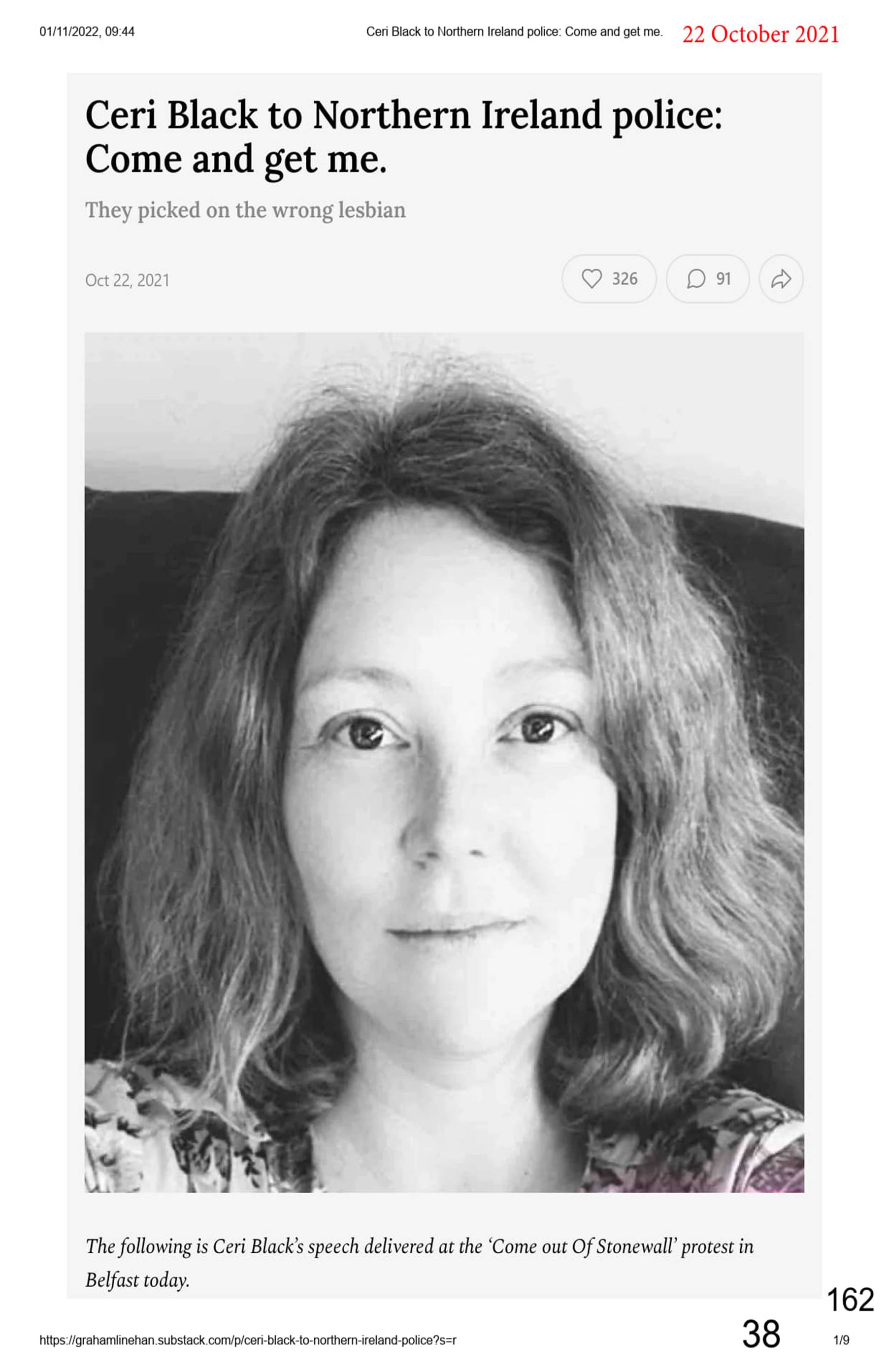
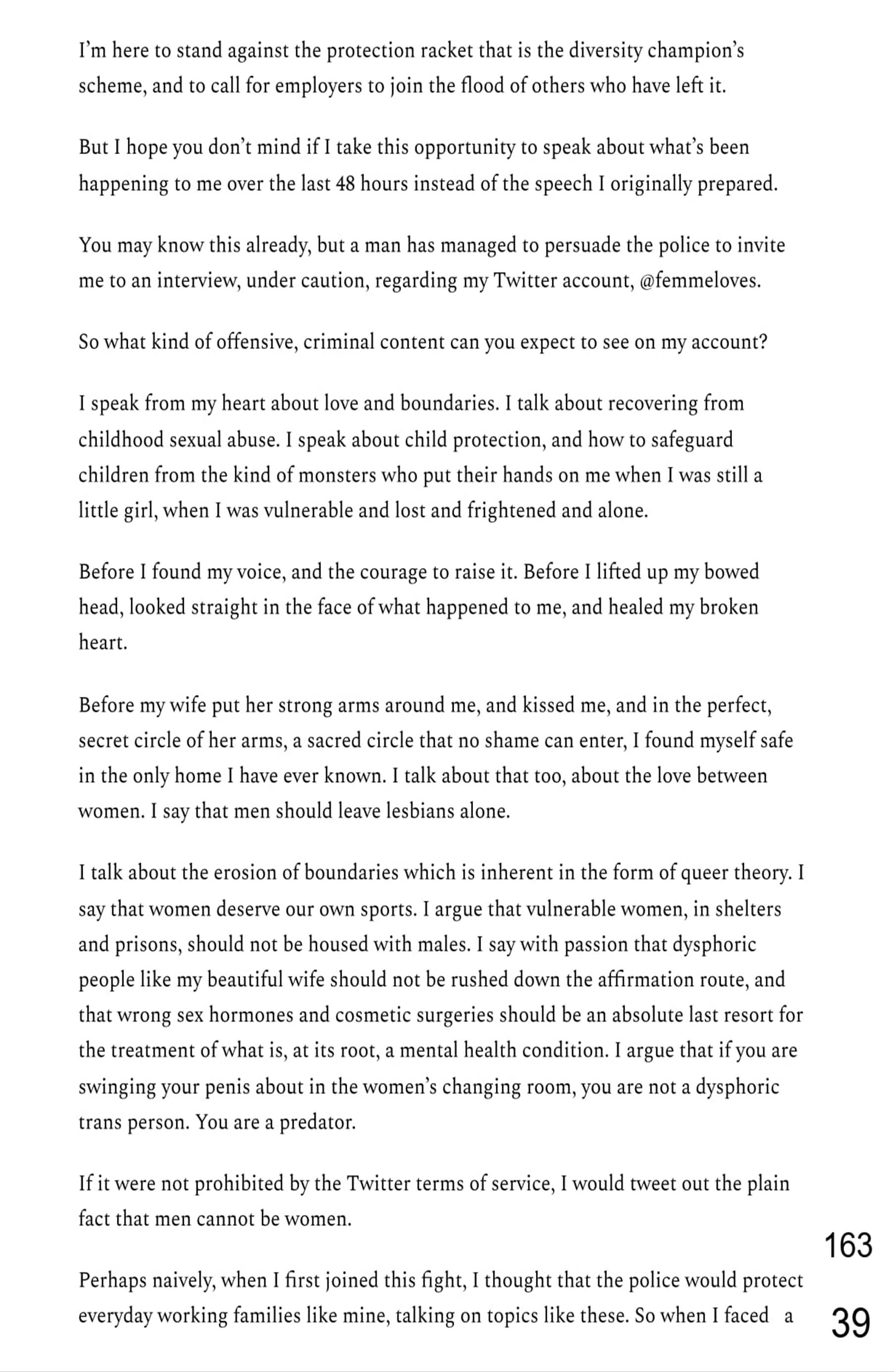
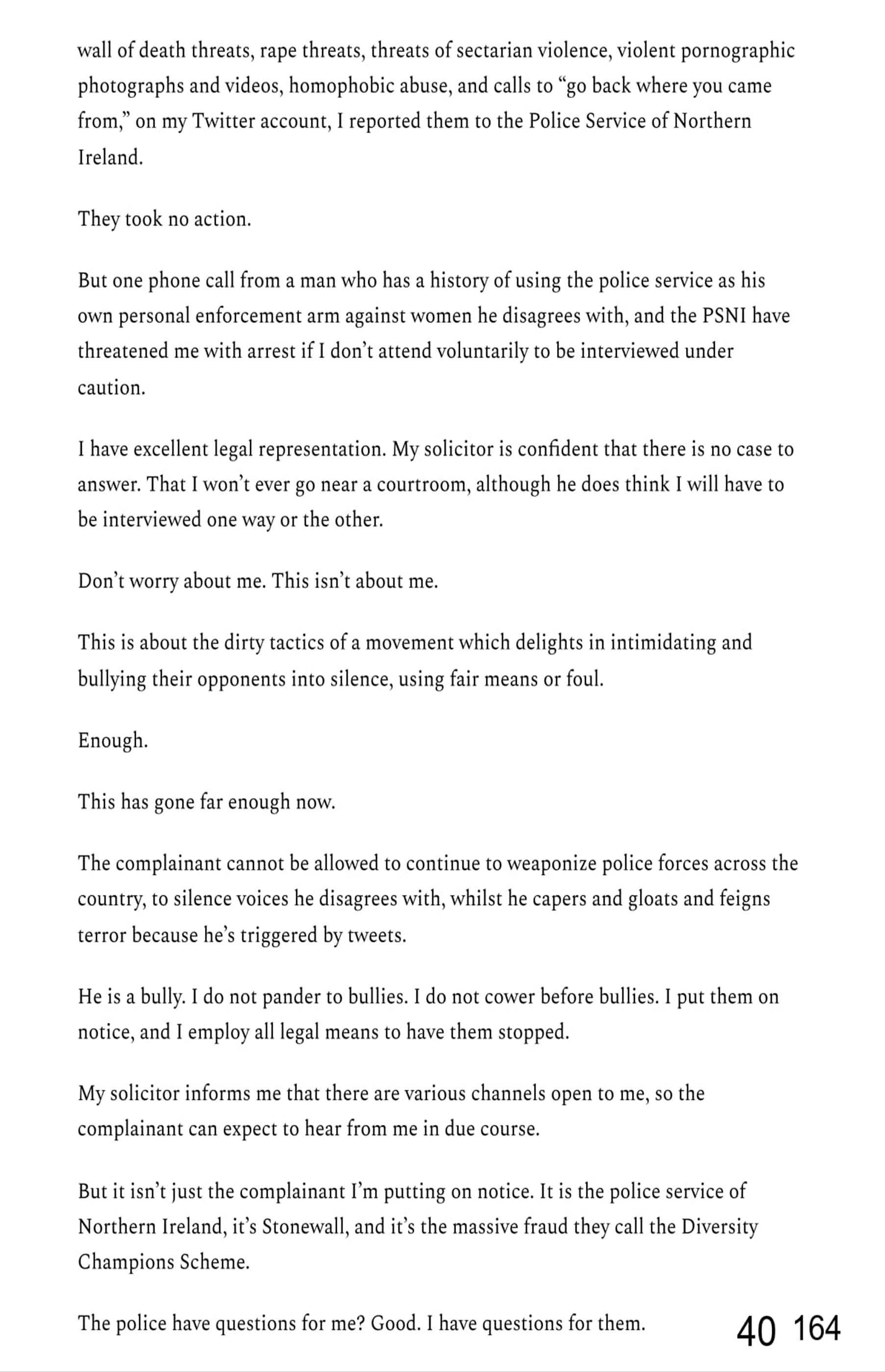
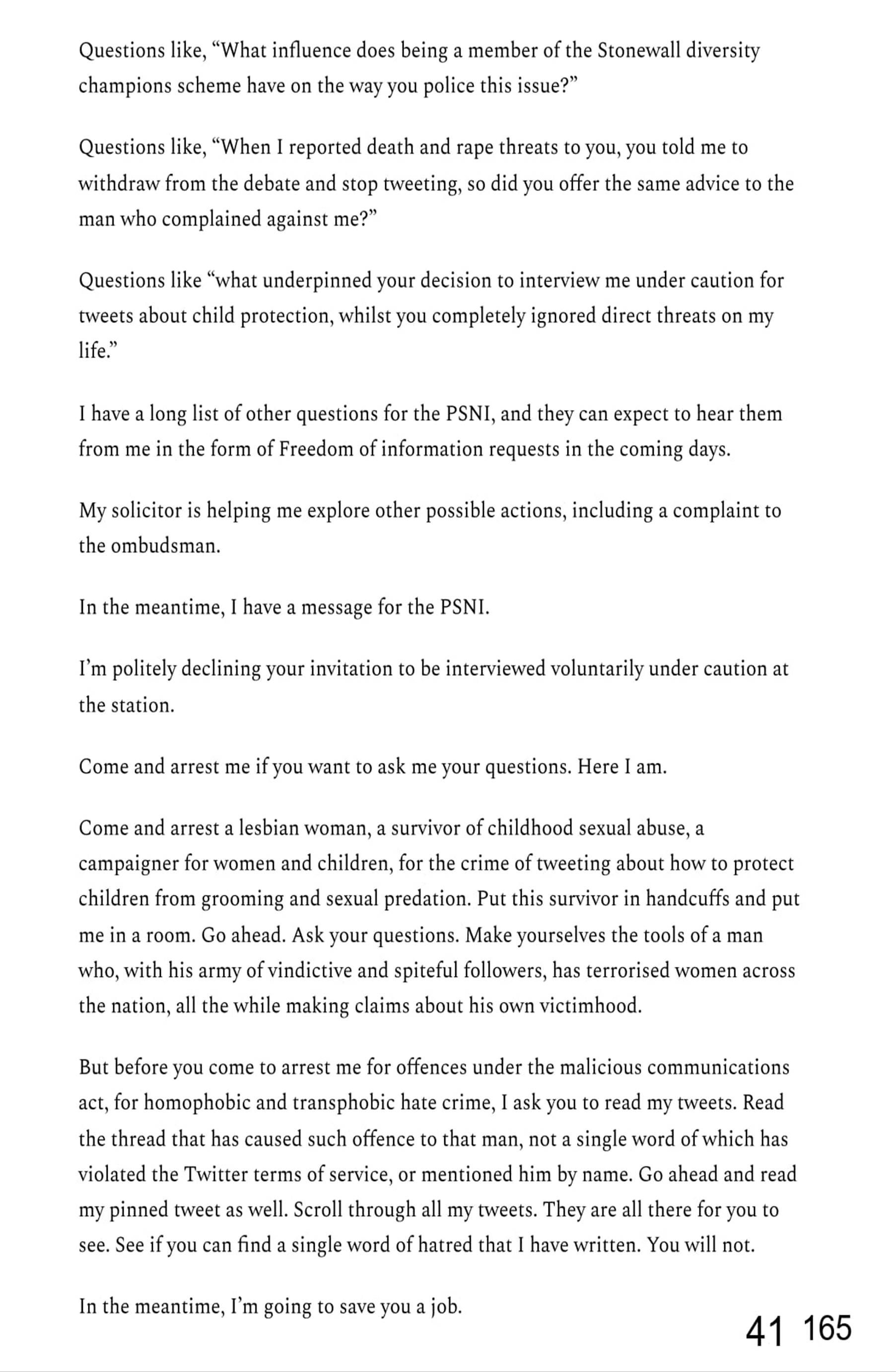
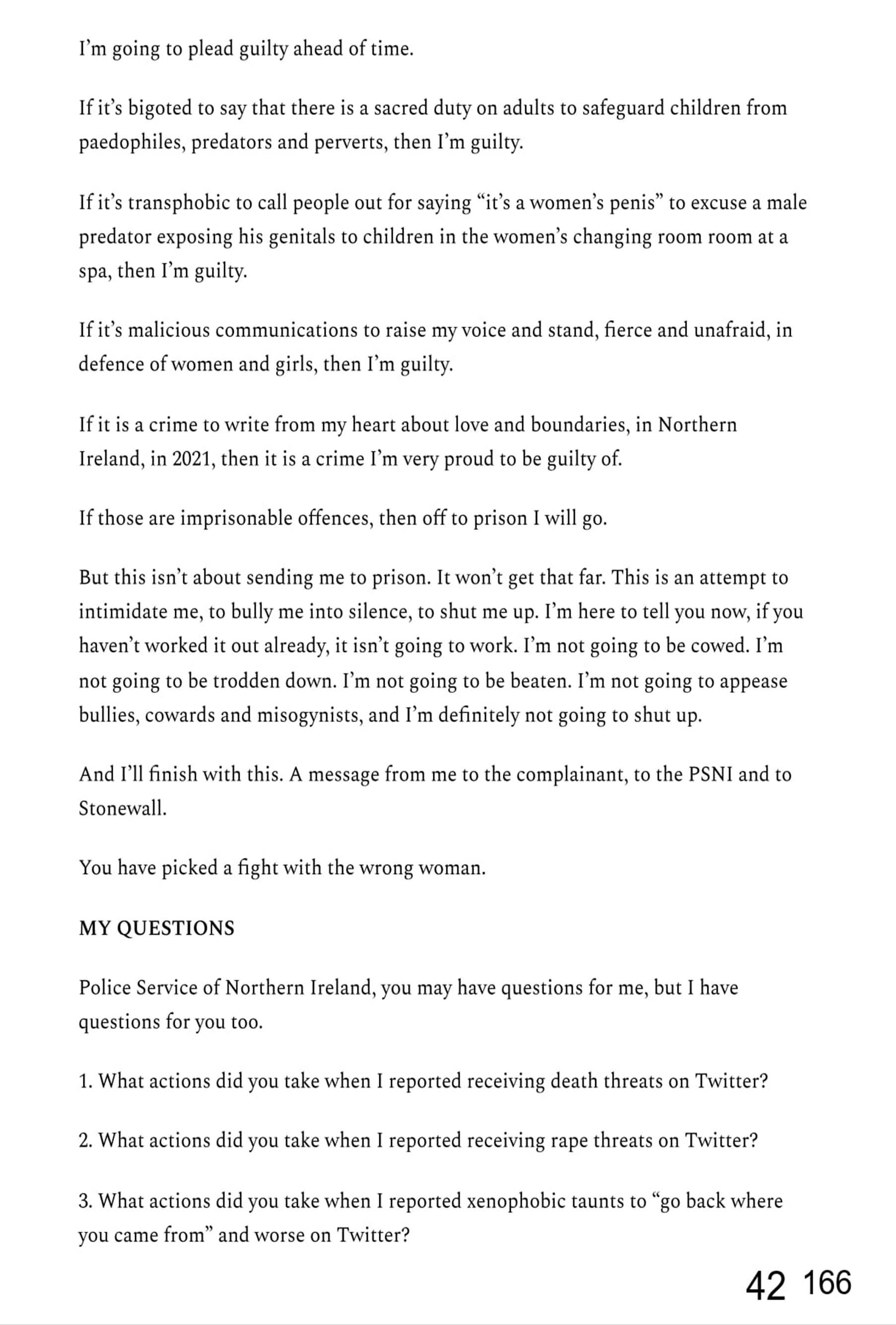
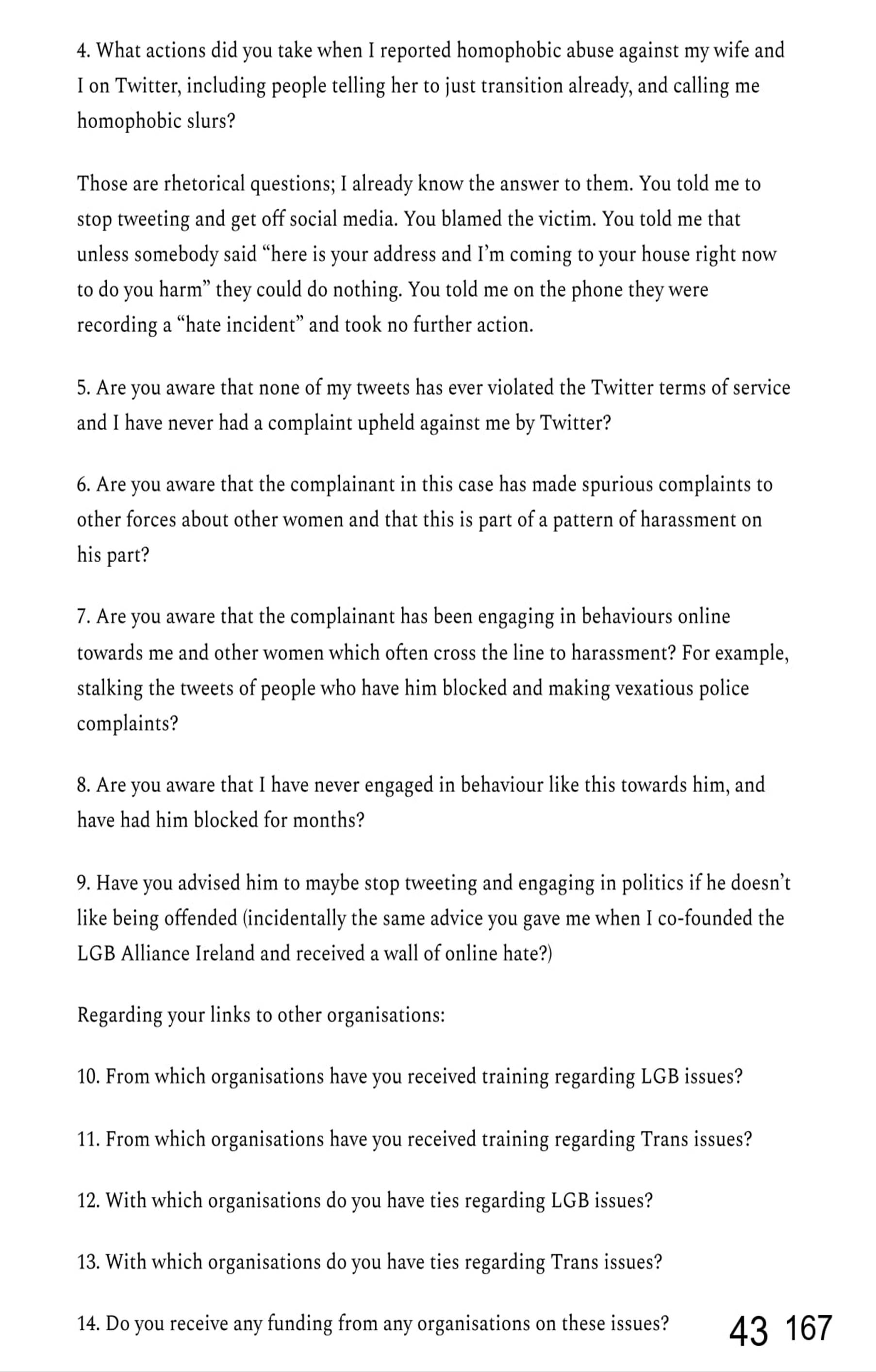
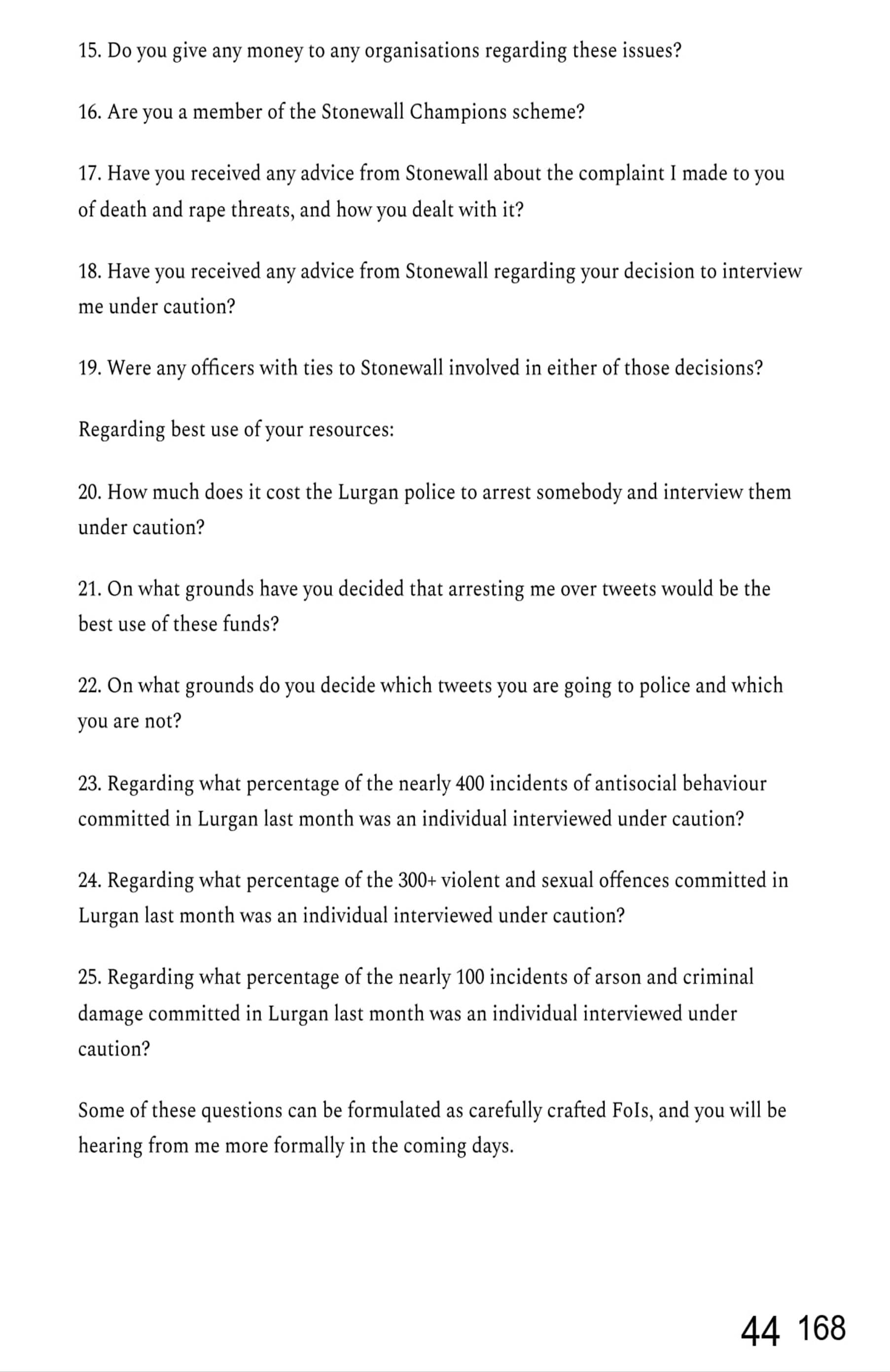
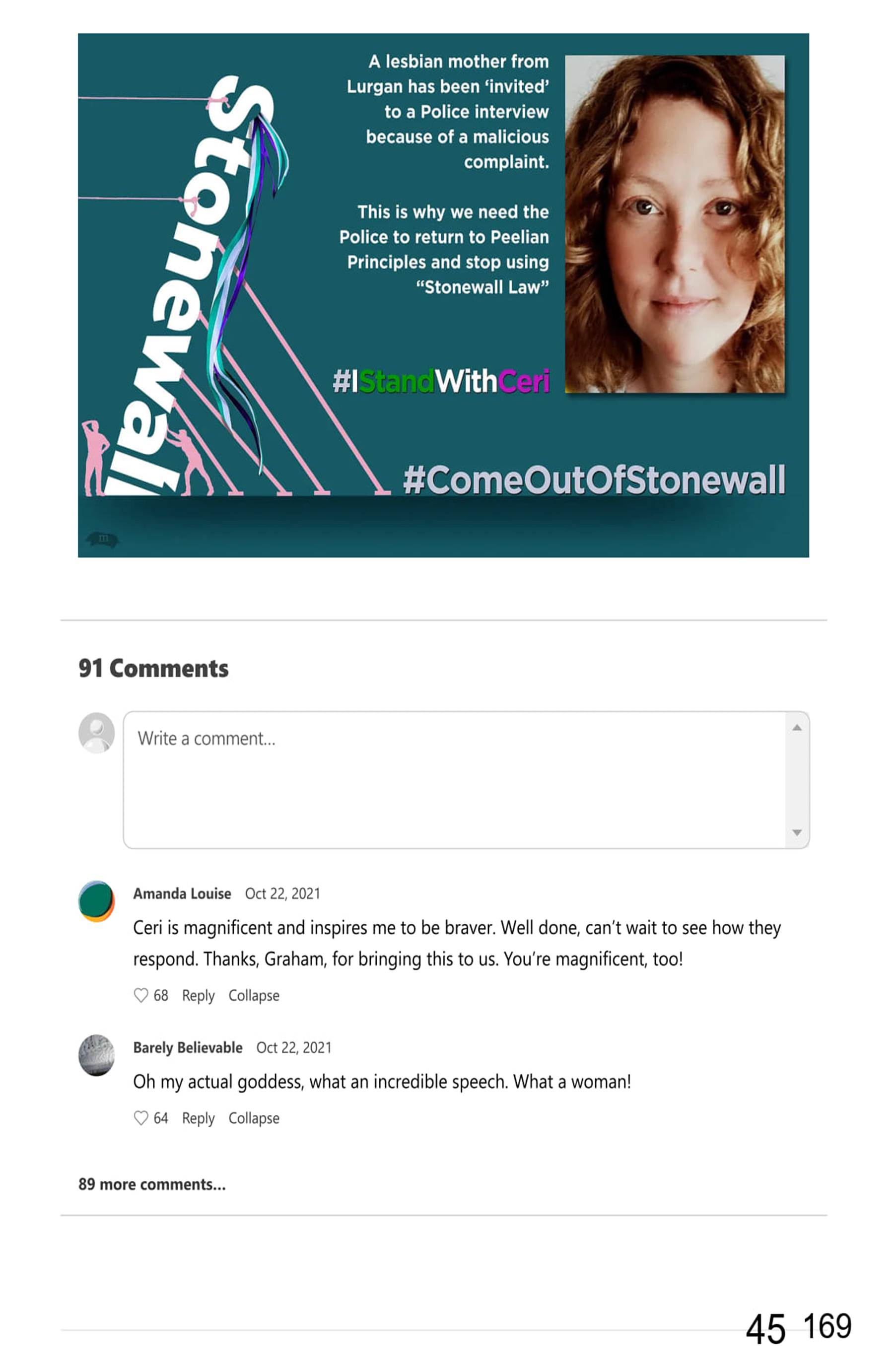

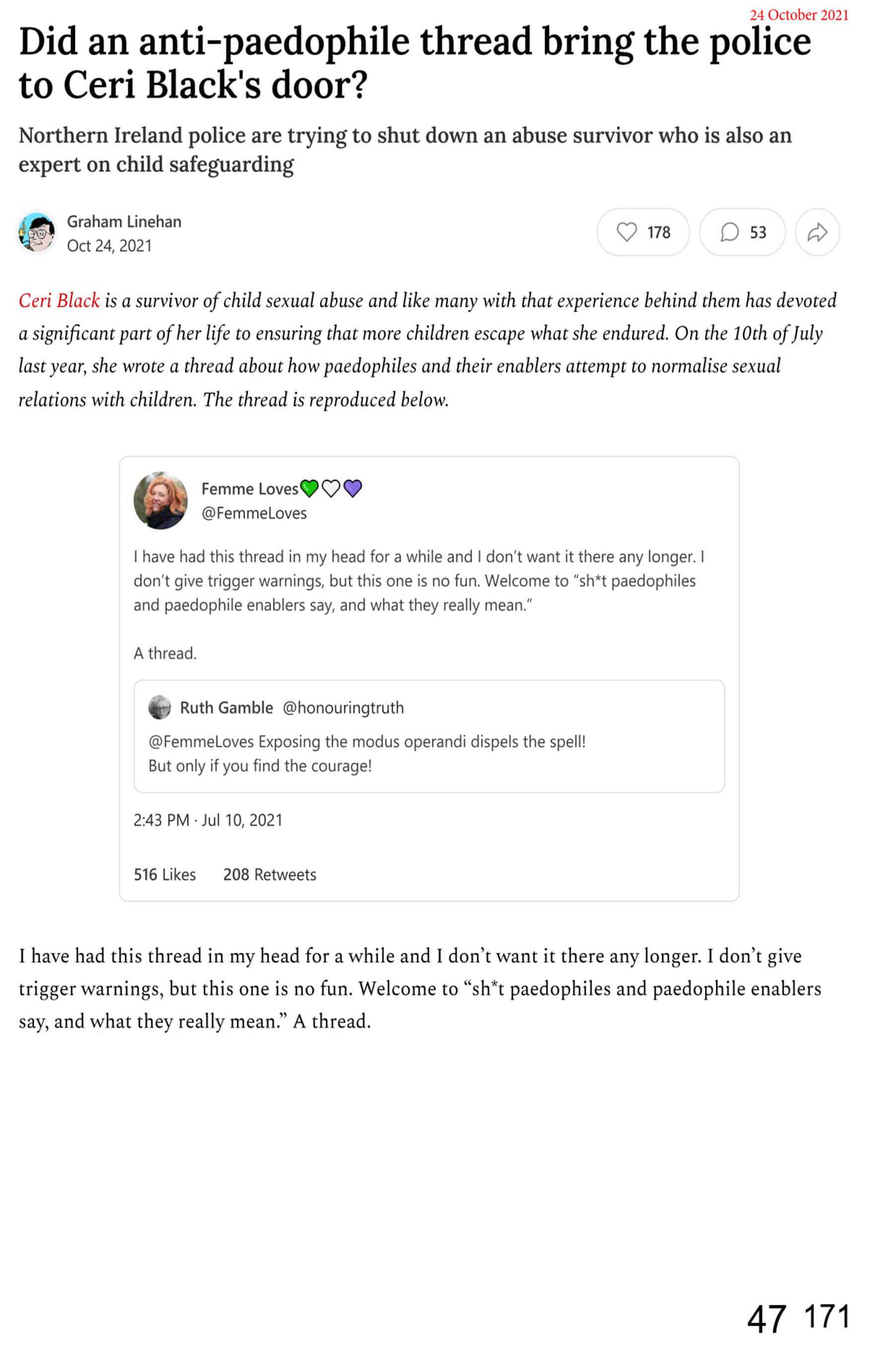
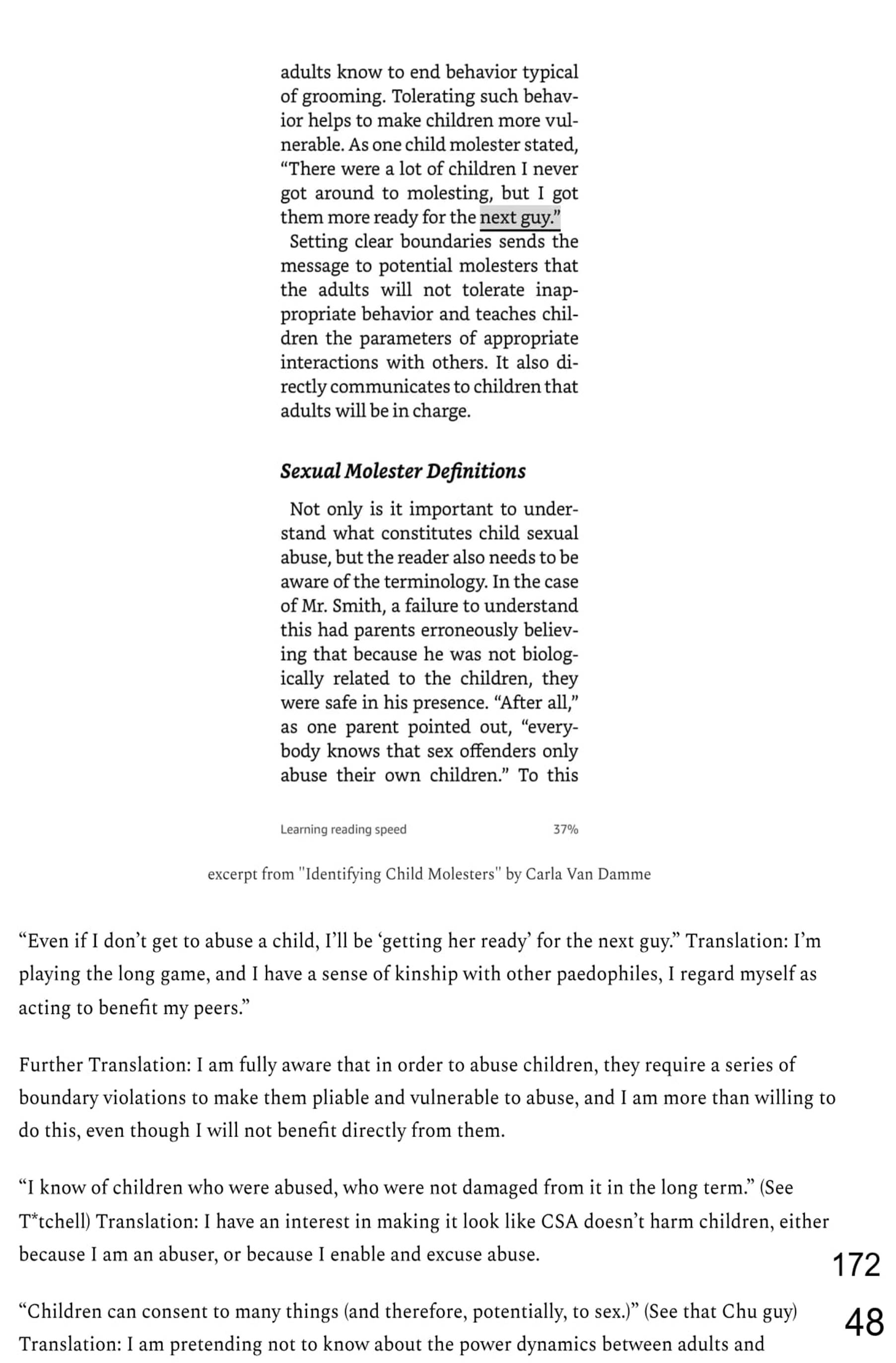
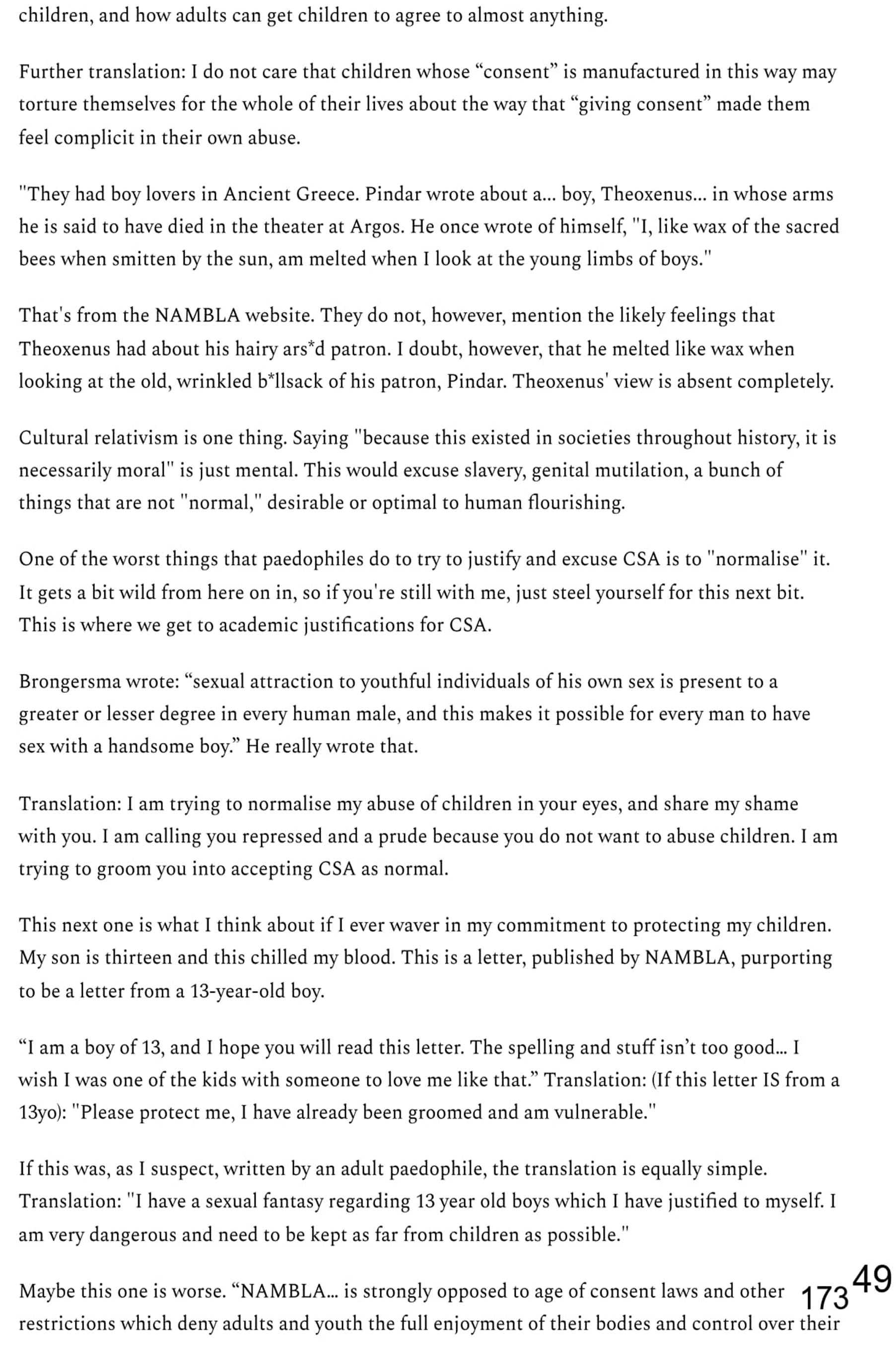
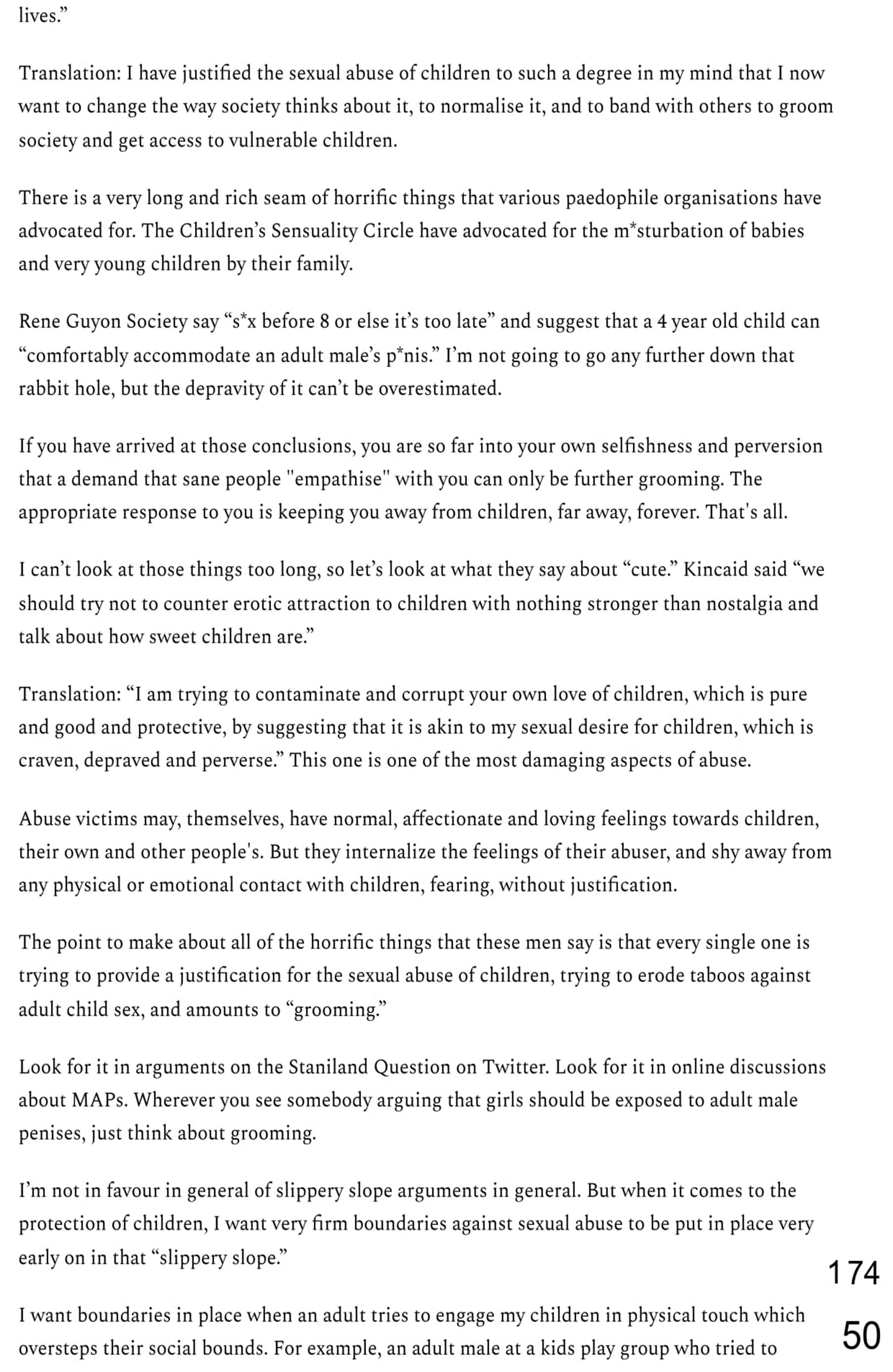
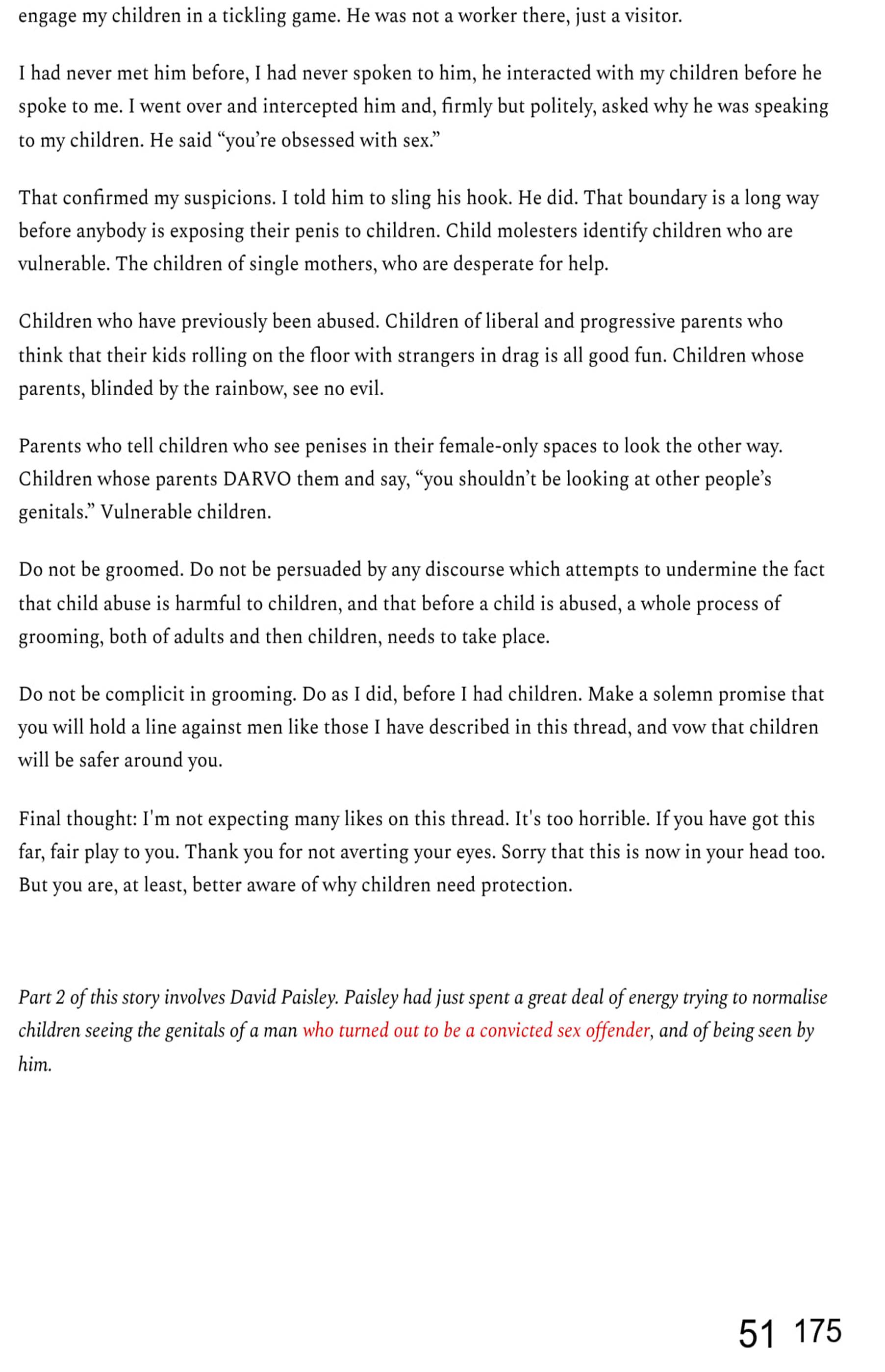
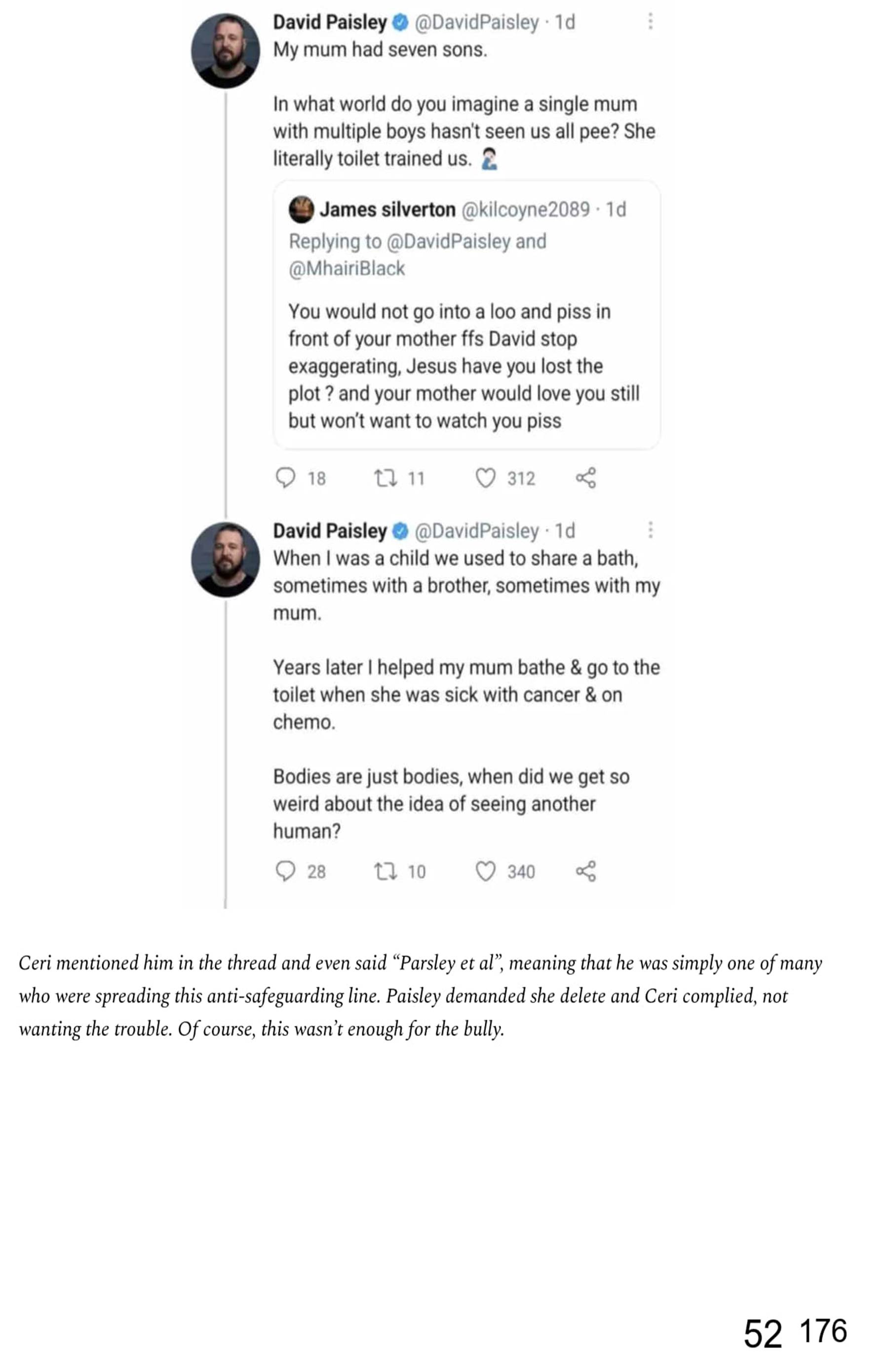
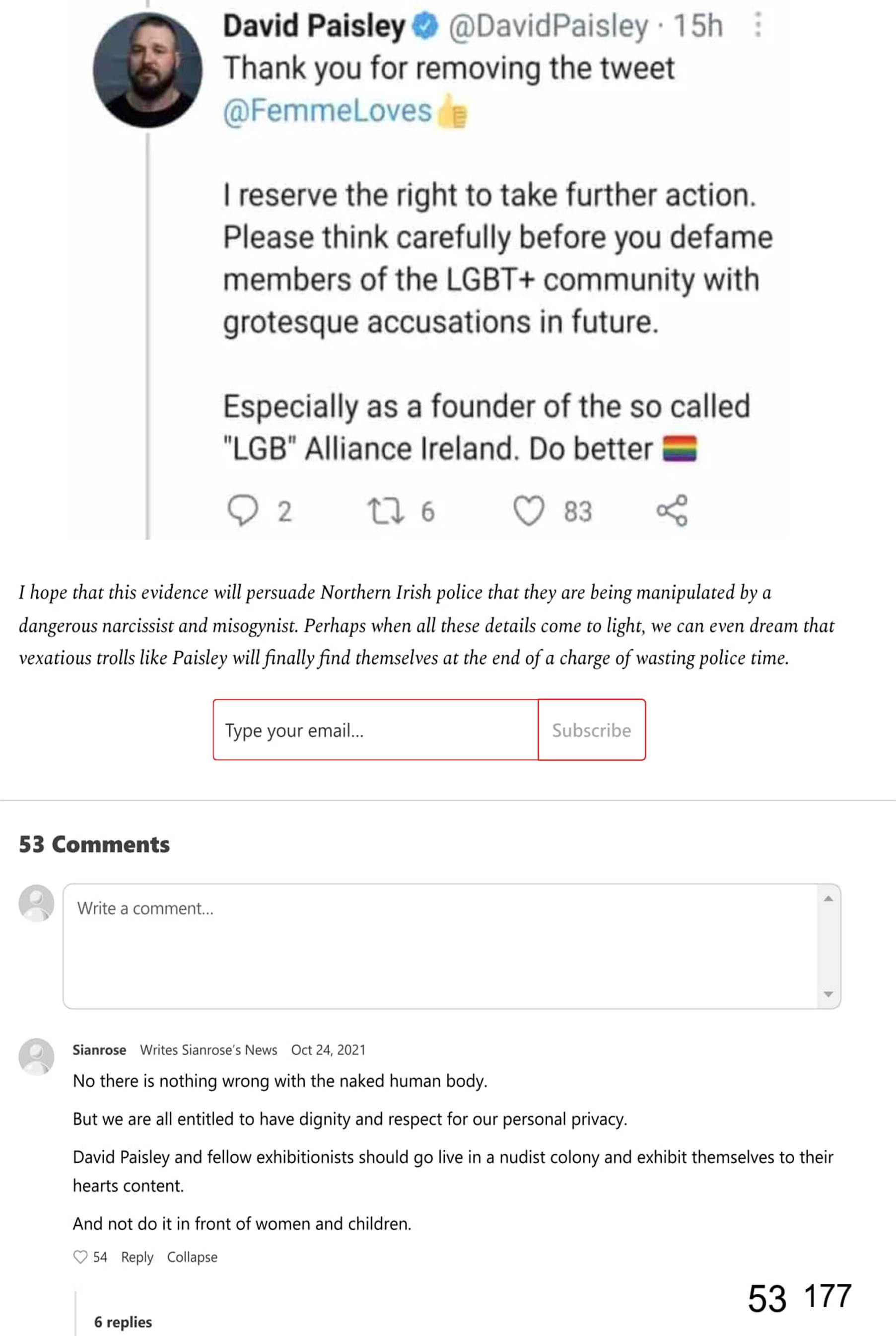

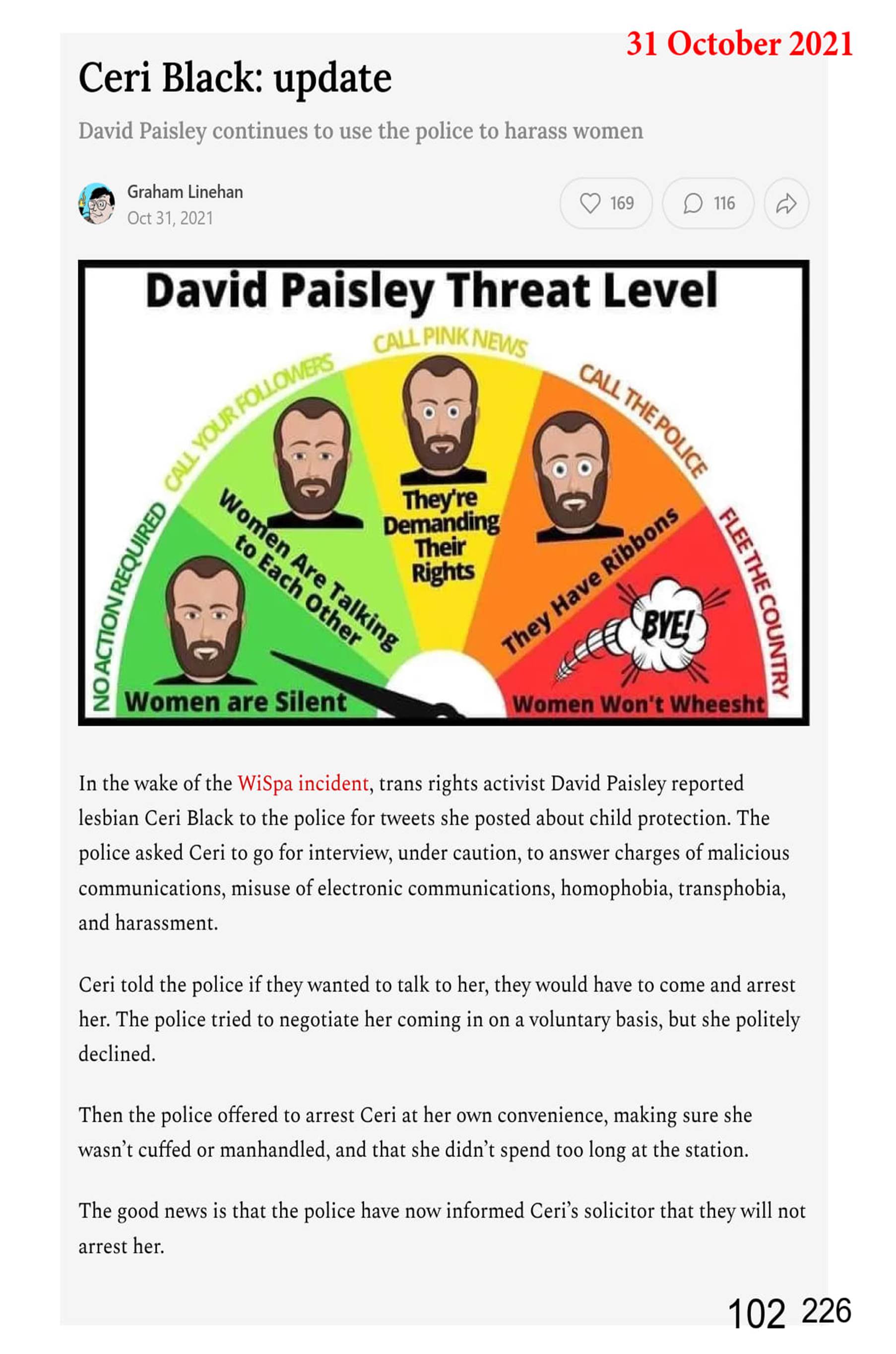
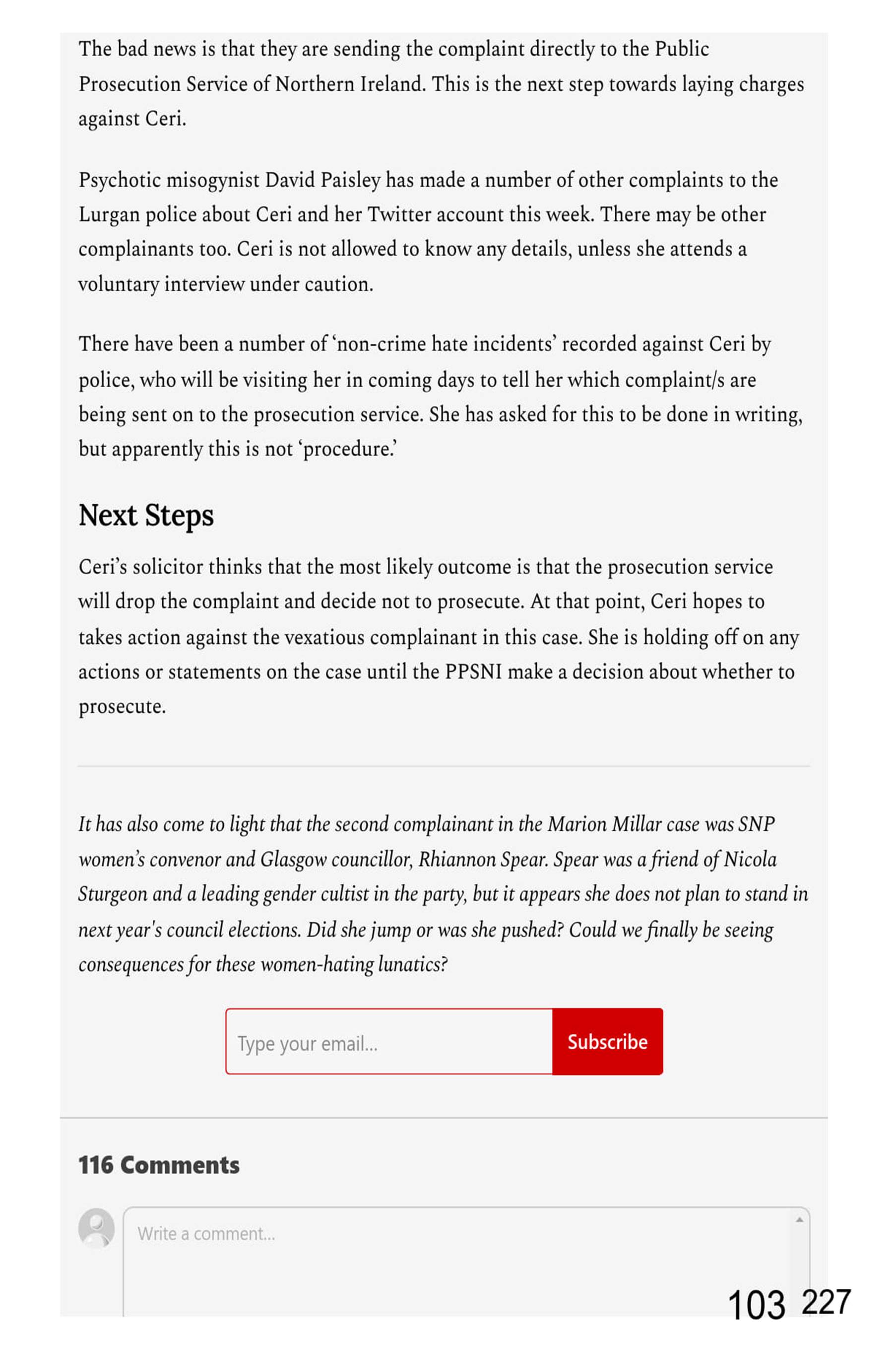
Note 1 In pleading his meanings, the Defendant has used ordinary text where he says the words are a necessary inclusion but not themselves defamatory, italics where he accepts the meaning is defamatory, and underlining to indicate opinion. I have reproduced his formatting in this judgment when setting out his meanings. [Back]
